Everyday cars which are already starting to disappear
Discussion
hondansx said:
battered said:
Mk1 Mondeo on the way to work this morning.
aFor me it's any Mondeo. With the Cavalier and Vectra, the Mondeo dominated the motorways. Now all the reps are in the more aspirational BMW or Audi, and if they want value Hyundai.
SUPERMINIS
Apologies for the rather long wait for this: my time has become more limited as fortunately, having been knobbled by Brexit, my work is picking up, as my clients seem to have started the New Year by sorting out projects that are likely to carry on irrespective of what happens from those that are in Brexit purdah. (Although, unfortunately we have had to close the business targeted at European institutional work down). Accordingly, these posts are likely to be rather more sporadic from now on, but I will plough on, as long as anyone is still interested, as I find them rather enjoyable: chatting informally about a subject dear to my heart is a refreshing change from the rather straight-laced nature of the day job!
In view of the inordinate wait before this appeared I have decided to analyse as much as possible in the sector, by selecting sixteen models, as a kind of bonus for late delivery. The models considered were as follows:
Citroen Saxo/C2/DS3: Saxo to 2004, C2 2003 to 2010, DS3 2010 onwards
Daewoo Lanos/Kalos/Chevrolet Kalos/Aveo: to 2004, Kalos 2003 to 2009, Aveo 2008-2014 (abandoned market).
Fiat Panda: First Gen. to 2003 (but not officially sold after 1996), Second Gen. 2004 onwards (although there are a handful of 2003 cars).
Fiat 500/Abarth
Ford Fiesta: Mk IV to 2002, Mk V 2002 to 2009, Mk VI 2008 onwards.
Honda Jazz: First Gen. 2001 to 2009, Second Gen.2009 to 2015, Third gen. 2015 onwards.
Hyundai Getz/i20: Getz to 2009, i20 from 2009 onwards.
Mini: R50/R53 to 2006, R56 2006 to 2014, F55/F56 2014 onwards.
Nissan Micra:
Peugeot 106/107/108: 106 to 2003, 107 2005 to 2014, 108 2014 onwards
Renault Clio: Clio 2 to 2008, Clio 3 2005 to 2013, Clio 4 2013 onwards.
Skoda Fabia: First Gen. to 2007, Second Gen. 2007 to 2015, Third Gen. 2015 onwards.
Suzuki Swift: First Gen, to 2003, Second Gen. 2005 to 2010, Third Gen. 2010 onwards.
Toyota Yaris: First Gen. to 2006, Second Gen 2006 to 2011, Third Gen 2011 onwards.
Vauxhall Corsa: Corsa C to 2006, Corsa D 2006 to 2015, Corsa E 2015 onwards
Volkswagen Polo: Mark 3 to 2002, Mark 4 2002 to 2009, Mark 5 2009 onwards.
As previously, anything that I could identify as not being a hatchback has been removed from the data, in attempt to keep the analysis on as an equivalent basis as is possible. As a result, I now know more about Mini special editions than I ever wanted to know! However, again as before, this process will not have been exhaustive: there are bound to be some convertibles, estates, coupes, etc. that still lurk in the data. In this respect identifying Fabia estates has been a particular issue.
Categorisation is a bit of issue with me in the supermini sector, given the overlap with the class below, and with the class above. One of the most obvious examples of this is in the Peugeot line, where, in my view, the 106 was unquestionably a supermini, whereas its direct lineal successors might be regarded as being in the class below; one thus has decide whether to follow the model line, or to take a strict view of what constitutes a supermini. Accordingly, this piece of work is a highly personal view of what constitutes a supermini in the context of this analysis. My apologies if what I have done does not correspond to your view.
Given that graphs with more than eight lines lack clarity, the initial graphical analysis splits the cars into two groups of cars (marque names A-M, and N-Z). Where appropriate, the top and bottom performing few models are then presented together for comparison.
As is customary we will look at the numbers of first registrations, for the two groups.
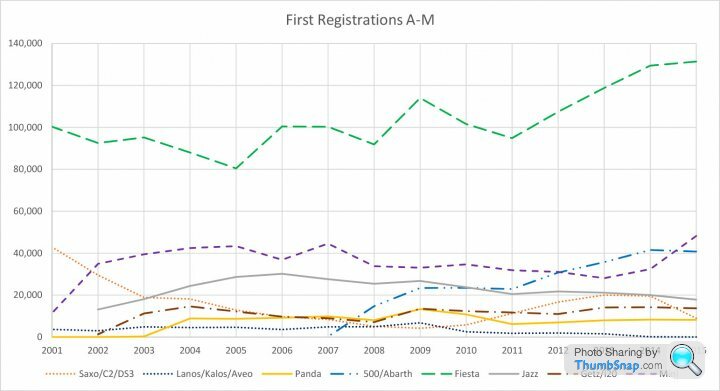
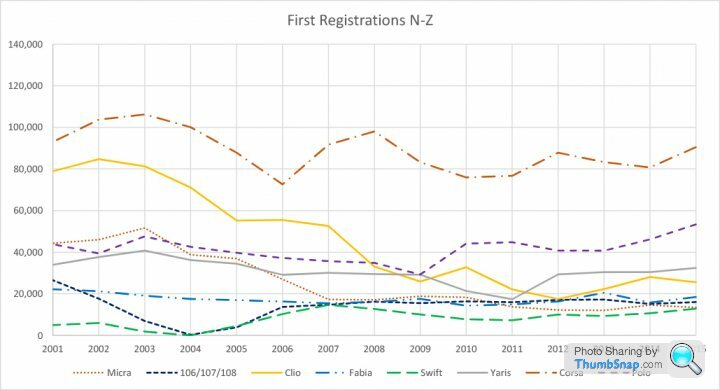
I believe these two graphs to be self-explanatory.
As we have included the majority of the models in the supermini market segment, we can make a reasonably close estimate of the total number of supermini hatchbacks registered in each year by adding the figures for the sixteen models considered together:
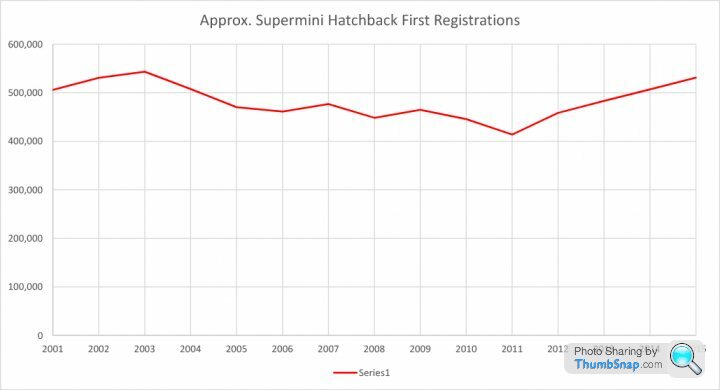
We can see that the number of supermini hatchbacks sold is broadly similar in 2015 to what it was in 2001 (increasing by 5.1% over the period). In detail, sales in the segment declined from 2003 to 2011, but have increased sharply and progressively since 2011, increasing by 28.4% between 2011 and 2015. I believe that we can ascribe this to two factors: firstly, the increasing size and comfort of cars in this class capturing sales from the family hatchback sector, and secondly, the growth of ‘fashion statement’ cars in the sector, such as the Mini and Fiat 500. The second argument is a little more tenuous, given that Mini sales have been fairly flat across the period, a spike in 2015 notwithstanding.
Moving onto survival rates the graphs for the 2001 to 2014 period for the two groups are as follows:
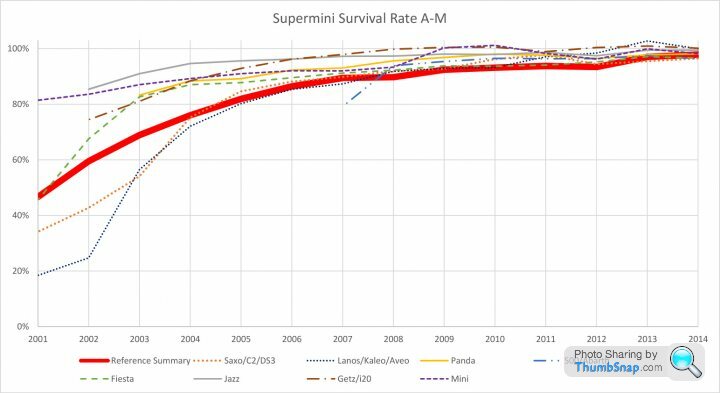
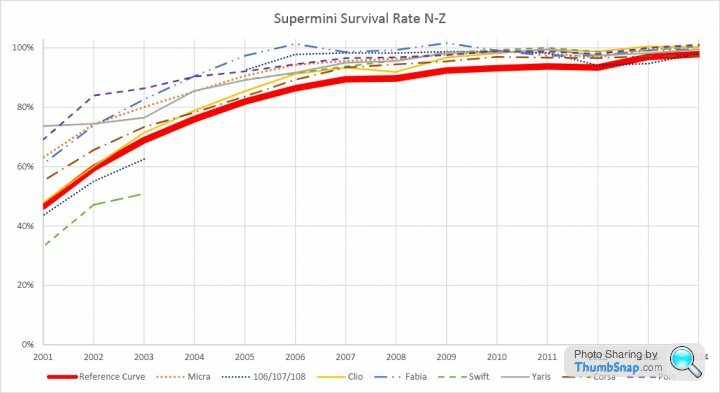
In certain years, when new, some of these cars achieve survival rates of slightly over 100% (101.4% maximum). Although I have already discussed some of the reasons behind this, I thought that it might be helpful to re-articulate and to expand on this apparently impossible phenomenon. There are two main reasons and several second order impacts for this. The first of the main reasons is that the datasets relating to vehicles that are taxed and SORNed relate to the United Kingdom as a whole, whereas those pertaining to registrations relate to Great Britain only, and is therefore an inherently smaller pool of vehicles. The second main reason is that new cars are identified by year of registration, whereas taxed and SORNed cars are identified by year of manufacture: it is inevitable that some cars are manufactured late one year and registered the next, as sales rates are not flat this introduces anomalies. Neither of these factors greatly distort the figures (we can see that the total impact of all the distorting factors is less than 3%), and are theoretically the same for all cars, although in practice differential impacts can be experienced for low sales volume cars that are exceptionally popular in Northern Ireland, for models that have large unsold inventories, and for those with longer distribution chains (e.g. from the Far East). Lesser impacts are caused by pre-registration of cars, which tends to bulk numbers of registrations in the years where it is most prevalent, and by importation of older cars into the British registration system.
Pre-registration is an interesting issue: in the case of almost all of these cars the SORN rate for 2015 cars is some way above that for 2014 cars and the years leading up to this. It should be stressed that there are other possible explanations, other than pre-registration for this phenomenon; however, I still find the following first year SORN rates interesting as a possible indicator of who it appears might be maintaining market share artificially through pre-registrations:
Citroen DS3: 0.51%
Fiat Panda: 0.05%
Fiat 500/Abarth: 0.58%
Ford Fiesta: 0.97%
Honda Jazz: 0.40%
Hyundai i20: 0.11%
Mini: 0.61%
Nissan Micra: 0.31%
Peugeot 108: 0.66%
Renault Clio: 0.22%
Skoda Fabia: 0.52%
Suzuki Swift: 0.41%
Toyota Yaris: 0.14%
Vauxhall Corsa: 0.32%
Volkswagen Polo: 0.30%
In the context of the current thread, the issue is whether registration above the initial natural demand level is likely to affect the long-term survival rate, and whether this would be confined to just the models in question, or would have wider impacts throughout the market segment. This is something that we can all pontificate about, but I cannot give you any firm evidence on the basis of the data currently available. Personally, I suspect that the answer will be driven by exogenous factors, not all of which are foreseeable. (Although some are not, e.g. will the bloated and gopping F55/F56 Mini be as appealing to purchasers of a female persuasion as the cute R50/R53 Mini is, a few years down the line?)
As ever, the 2001 to 2009 portion of the survival curves are the most interesting part:
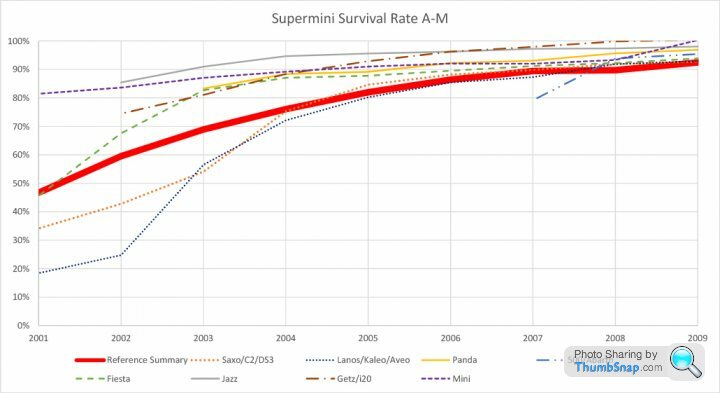
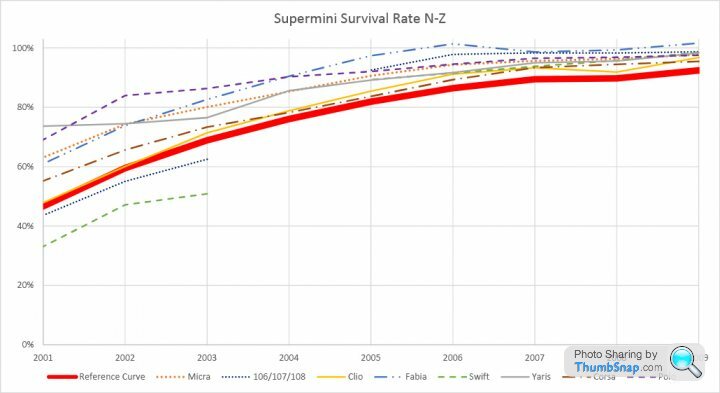
As one would expect, survival rates in the market segment tend to be above the reference survival curve, given that we are talking about a type of vehicle that has strong second-hand demand, as a second family car, and as a point of entry to the car market, and also one where the cost of repairs tends to be lower.
There is room for debate about the top five performers in the segment in the PH survival stakes. I have taken the view that it is the VW Polo, the Skoda Fabia and the Fiat Panda that deserve a place in the top five, alongside the Honda Jazz and the Mini.
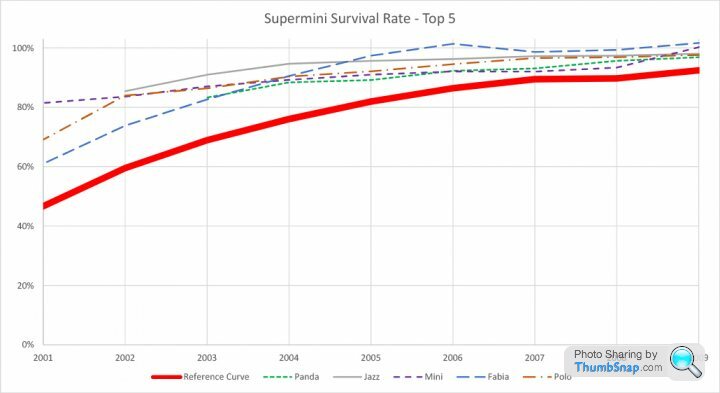
This is another strong performance by Honda, with the Jazz taking over from the Fabia in the survival rate stakes once cars’ tenth birthday has passed; however, as the Jazz was only introduced in 2002, the lack of 2001 data does not allow its long-term dominance to be confirmed. The Mini is exceptional in that it has a linear rate of decline, with no evidence (yet) of a steepening rate of decline with age, the BMW 0 Series 81.44% survival rate for 2001 cars establishes a new record in this work. It is conceivable that cars are mainly falling by the wayside as a result of accident damage. Even though the Mini survival rate is always below that of the Jazz I will make the bold prediction that it will overtake the Jazz by cars fifteenth birthdays: the Mini has a trendiness that the Jazz lacks, with its image as a grannymobile, and thus Minis are more likely to survive the need for big repair bills, in my view.
Moving on to the bottom three, which corresponds more with the theme of the thread:
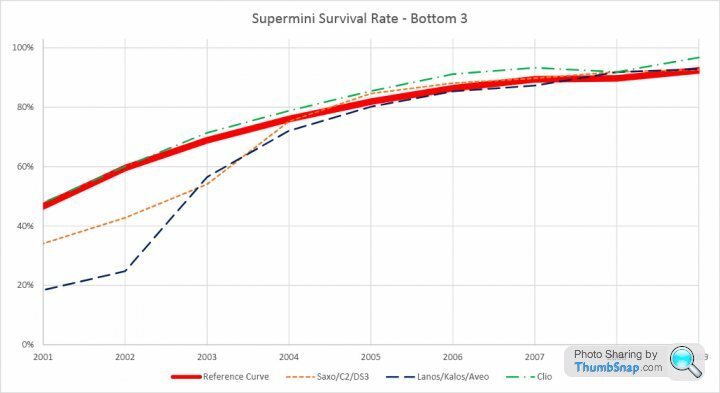
Probably, it is unfair to lump the Renault Clio in with the Citroen Saxo/C2 and the Chevroloo Lanos/Kalos/Aveo, as its survival rate is not bad: hovering just above the survival reference line throughout. Indeed, the Renault Clio has a decidedly better survival rate than the Peugeot 106 and the First Generation Suzuki Swift, but both of these escape inclusion as result of vastly improved performance by their successors. The Clio is a victim of the high standards set by others. There can be no doubt about the inclusion of the Saxo and the Chevroloo though. It is quite likely that the Saxo survival rates have been dragged down a bit by their ownership demographic, but no such excuse can be made for the Chevroloo, which achieves wretched survival rates. On this evidence, it is perhaps no surprise that Chevroloo have retreated from the European market. This is a car that is set to disappear from our roads, and having had the misfortune to drive an Aveo on several occasions, I say good riddance!
In simple terms a fourteen year-old Lanos is almost four and half times as likely as a Mini to be feeding the furnaces.
[DETAILED MODEL BY MODEL ANALYSIS TO FOLLOW IN UPDATED POST IN THE NEXT FEW DAYS]
Apologies for the rather long wait for this: my time has become more limited as fortunately, having been knobbled by Brexit, my work is picking up, as my clients seem to have started the New Year by sorting out projects that are likely to carry on irrespective of what happens from those that are in Brexit purdah. (Although, unfortunately we have had to close the business targeted at European institutional work down). Accordingly, these posts are likely to be rather more sporadic from now on, but I will plough on, as long as anyone is still interested, as I find them rather enjoyable: chatting informally about a subject dear to my heart is a refreshing change from the rather straight-laced nature of the day job!
In view of the inordinate wait before this appeared I have decided to analyse as much as possible in the sector, by selecting sixteen models, as a kind of bonus for late delivery. The models considered were as follows:
Citroen Saxo/C2/DS3: Saxo to 2004, C2 2003 to 2010, DS3 2010 onwards
Daewoo Lanos/Kalos/Chevrolet Kalos/Aveo: to 2004, Kalos 2003 to 2009, Aveo 2008-2014 (abandoned market).
Fiat Panda: First Gen. to 2003 (but not officially sold after 1996), Second Gen. 2004 onwards (although there are a handful of 2003 cars).
Fiat 500/Abarth
Ford Fiesta: Mk IV to 2002, Mk V 2002 to 2009, Mk VI 2008 onwards.
Honda Jazz: First Gen. 2001 to 2009, Second Gen.2009 to 2015, Third gen. 2015 onwards.
Hyundai Getz/i20: Getz to 2009, i20 from 2009 onwards.
Mini: R50/R53 to 2006, R56 2006 to 2014, F55/F56 2014 onwards.
Nissan Micra:
Peugeot 106/107/108: 106 to 2003, 107 2005 to 2014, 108 2014 onwards
Renault Clio: Clio 2 to 2008, Clio 3 2005 to 2013, Clio 4 2013 onwards.
Skoda Fabia: First Gen. to 2007, Second Gen. 2007 to 2015, Third Gen. 2015 onwards.
Suzuki Swift: First Gen, to 2003, Second Gen. 2005 to 2010, Third Gen. 2010 onwards.
Toyota Yaris: First Gen. to 2006, Second Gen 2006 to 2011, Third Gen 2011 onwards.
Vauxhall Corsa: Corsa C to 2006, Corsa D 2006 to 2015, Corsa E 2015 onwards
Volkswagen Polo: Mark 3 to 2002, Mark 4 2002 to 2009, Mark 5 2009 onwards.
As previously, anything that I could identify as not being a hatchback has been removed from the data, in attempt to keep the analysis on as an equivalent basis as is possible. As a result, I now know more about Mini special editions than I ever wanted to know! However, again as before, this process will not have been exhaustive: there are bound to be some convertibles, estates, coupes, etc. that still lurk in the data. In this respect identifying Fabia estates has been a particular issue.
Categorisation is a bit of issue with me in the supermini sector, given the overlap with the class below, and with the class above. One of the most obvious examples of this is in the Peugeot line, where, in my view, the 106 was unquestionably a supermini, whereas its direct lineal successors might be regarded as being in the class below; one thus has decide whether to follow the model line, or to take a strict view of what constitutes a supermini. Accordingly, this piece of work is a highly personal view of what constitutes a supermini in the context of this analysis. My apologies if what I have done does not correspond to your view.
Given that graphs with more than eight lines lack clarity, the initial graphical analysis splits the cars into two groups of cars (marque names A-M, and N-Z). Where appropriate, the top and bottom performing few models are then presented together for comparison.
As is customary we will look at the numbers of first registrations, for the two groups.


I believe these two graphs to be self-explanatory.
As we have included the majority of the models in the supermini market segment, we can make a reasonably close estimate of the total number of supermini hatchbacks registered in each year by adding the figures for the sixteen models considered together:

We can see that the number of supermini hatchbacks sold is broadly similar in 2015 to what it was in 2001 (increasing by 5.1% over the period). In detail, sales in the segment declined from 2003 to 2011, but have increased sharply and progressively since 2011, increasing by 28.4% between 2011 and 2015. I believe that we can ascribe this to two factors: firstly, the increasing size and comfort of cars in this class capturing sales from the family hatchback sector, and secondly, the growth of ‘fashion statement’ cars in the sector, such as the Mini and Fiat 500. The second argument is a little more tenuous, given that Mini sales have been fairly flat across the period, a spike in 2015 notwithstanding.
Moving onto survival rates the graphs for the 2001 to 2014 period for the two groups are as follows:


In certain years, when new, some of these cars achieve survival rates of slightly over 100% (101.4% maximum). Although I have already discussed some of the reasons behind this, I thought that it might be helpful to re-articulate and to expand on this apparently impossible phenomenon. There are two main reasons and several second order impacts for this. The first of the main reasons is that the datasets relating to vehicles that are taxed and SORNed relate to the United Kingdom as a whole, whereas those pertaining to registrations relate to Great Britain only, and is therefore an inherently smaller pool of vehicles. The second main reason is that new cars are identified by year of registration, whereas taxed and SORNed cars are identified by year of manufacture: it is inevitable that some cars are manufactured late one year and registered the next, as sales rates are not flat this introduces anomalies. Neither of these factors greatly distort the figures (we can see that the total impact of all the distorting factors is less than 3%), and are theoretically the same for all cars, although in practice differential impacts can be experienced for low sales volume cars that are exceptionally popular in Northern Ireland, for models that have large unsold inventories, and for those with longer distribution chains (e.g. from the Far East). Lesser impacts are caused by pre-registration of cars, which tends to bulk numbers of registrations in the years where it is most prevalent, and by importation of older cars into the British registration system.
Pre-registration is an interesting issue: in the case of almost all of these cars the SORN rate for 2015 cars is some way above that for 2014 cars and the years leading up to this. It should be stressed that there are other possible explanations, other than pre-registration for this phenomenon; however, I still find the following first year SORN rates interesting as a possible indicator of who it appears might be maintaining market share artificially through pre-registrations:
Citroen DS3: 0.51%
Fiat Panda: 0.05%
Fiat 500/Abarth: 0.58%
Ford Fiesta: 0.97%
Honda Jazz: 0.40%
Hyundai i20: 0.11%
Mini: 0.61%
Nissan Micra: 0.31%
Peugeot 108: 0.66%
Renault Clio: 0.22%
Skoda Fabia: 0.52%
Suzuki Swift: 0.41%
Toyota Yaris: 0.14%
Vauxhall Corsa: 0.32%
Volkswagen Polo: 0.30%
In the context of the current thread, the issue is whether registration above the initial natural demand level is likely to affect the long-term survival rate, and whether this would be confined to just the models in question, or would have wider impacts throughout the market segment. This is something that we can all pontificate about, but I cannot give you any firm evidence on the basis of the data currently available. Personally, I suspect that the answer will be driven by exogenous factors, not all of which are foreseeable. (Although some are not, e.g. will the bloated and gopping F55/F56 Mini be as appealing to purchasers of a female persuasion as the cute R50/R53 Mini is, a few years down the line?)
As ever, the 2001 to 2009 portion of the survival curves are the most interesting part:


As one would expect, survival rates in the market segment tend to be above the reference survival curve, given that we are talking about a type of vehicle that has strong second-hand demand, as a second family car, and as a point of entry to the car market, and also one where the cost of repairs tends to be lower.
There is room for debate about the top five performers in the segment in the PH survival stakes. I have taken the view that it is the VW Polo, the Skoda Fabia and the Fiat Panda that deserve a place in the top five, alongside the Honda Jazz and the Mini.

This is another strong performance by Honda, with the Jazz taking over from the Fabia in the survival rate stakes once cars’ tenth birthday has passed; however, as the Jazz was only introduced in 2002, the lack of 2001 data does not allow its long-term dominance to be confirmed. The Mini is exceptional in that it has a linear rate of decline, with no evidence (yet) of a steepening rate of decline with age, the BMW 0 Series 81.44% survival rate for 2001 cars establishes a new record in this work. It is conceivable that cars are mainly falling by the wayside as a result of accident damage. Even though the Mini survival rate is always below that of the Jazz I will make the bold prediction that it will overtake the Jazz by cars fifteenth birthdays: the Mini has a trendiness that the Jazz lacks, with its image as a grannymobile, and thus Minis are more likely to survive the need for big repair bills, in my view.
Moving on to the bottom three, which corresponds more with the theme of the thread:

Probably, it is unfair to lump the Renault Clio in with the Citroen Saxo/C2 and the Chevroloo Lanos/Kalos/Aveo, as its survival rate is not bad: hovering just above the survival reference line throughout. Indeed, the Renault Clio has a decidedly better survival rate than the Peugeot 106 and the First Generation Suzuki Swift, but both of these escape inclusion as result of vastly improved performance by their successors. The Clio is a victim of the high standards set by others. There can be no doubt about the inclusion of the Saxo and the Chevroloo though. It is quite likely that the Saxo survival rates have been dragged down a bit by their ownership demographic, but no such excuse can be made for the Chevroloo, which achieves wretched survival rates. On this evidence, it is perhaps no surprise that Chevroloo have retreated from the European market. This is a car that is set to disappear from our roads, and having had the misfortune to drive an Aveo on several occasions, I say good riddance!
In simple terms a fourteen year-old Lanos is almost four and half times as likely as a Mini to be feeding the furnaces.
[DETAILED MODEL BY MODEL ANALYSIS TO FOLLOW IN UPDATED POST IN THE NEXT FEW DAYS]
Edited by Car_Nut on Tuesday 31st January 00:29
Amazing work as always, i find this sort of statistical work fascinating. As regards the bottom three performers do you think Renualtsport models could be holding the number of older Clios up? Not sure if these are included in the data set. Also perhaps to a lesser extent sporting models of the Saxo? With no sporting models which we have seen tend to stick around longer perhaps the Chevy/Korean cars are just white goods which are run into the ground?
Funky Panda said:
Amazing work as always, i find this sort of statistical work fascinating. As regards the bottom three performers do you think Renualtsport models could be holding the number of older Clios up? Not sure if these are included in the data set. Also perhaps to a lesser extent sporting models of the Saxo? With no sporting models which we have seen tend to stick around longer perhaps the Chevy/Korean cars are just white goods which are run into the ground?
Thanks for the kind words - glad to hear that I am not the only one that finds this kind of stuff interesting. Some good points that I will discuss in turn.Separating RenaultSport Clios from the rest:
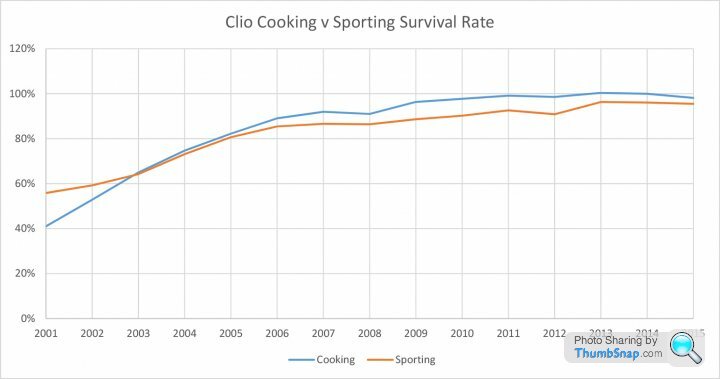
As we can see the initial wastage rates are greater for the sporting models, for reasons that we can all suspect, then once the cars get to around eight or nine years old the cooking and sporting models follow the same rate of decline, before suddenly when the cars reach about twelve years old the sporting models become recognised as modern classics and the scrappage rate drops off. As the cars age further the gulf in the survival advantage of sporting models will only grow.
Doing the same thing for the Saxo, by analysing the VTS and VTR models separately:
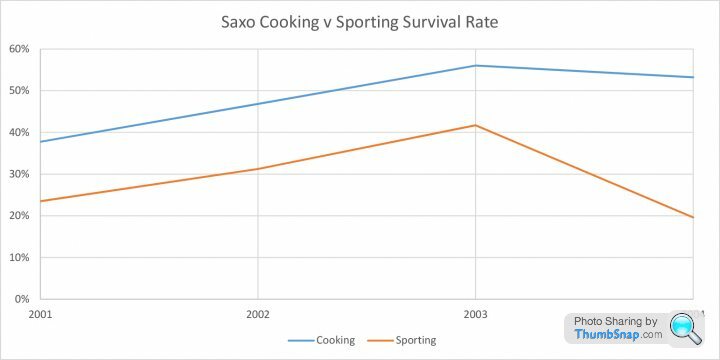
In the case of the Saxo, the rule that sporting models survive better is not valid. I would suggest that this is down to the yoof factors that afflict this model. That much is not surprising I would suggest, but what is surprising is that both the sporting and non-sporting models are still following the same trend of decline.
While I take the 'white goods' point, I would suggest that this equally applies to cars like the Hyundai Getz, Toyota Yaris, and of course the Honda Jazz, yet all of these have survival rates that are vastly better than that of the Chevroloo, whose survival rate can only be described as abysmal.
Very interesting. I wonder if the dip in Renualt sport clio survival around 2010 can be explained by them being converted to race cars to run in the road class of the BARC championship at least 50-60 must have gone this way? Plus conversion to non road legal track cars.
The saxo does seem to buck the trend so I can only imagine many of these end up of the black stuff. It's no wonder they are expensive to insure.
The Daewoos really could be extinct in a few years at that drop off. I wonder if those badged as Chevys may do better if the survival stakes?
The saxo does seem to buck the trend so I can only imagine many of these end up of the black stuff. It's no wonder they are expensive to insure.
The Daewoos really could be extinct in a few years at that drop off. I wonder if those badged as Chevys may do better if the survival stakes?
Seriously cracking read this thread. Loving the stats and stories posted thus far! 
Brings back a lot of memories the mention of some of the cars on here for me. Really considering taking on the challenge/hobby of trying to spot as many cars of the same ilk mentioned on here as I can for the coming year perhaps...

Brings back a lot of memories the mention of some of the cars on here for me. Really considering taking on the challenge/hobby of trying to spot as many cars of the same ilk mentioned on here as I can for the coming year perhaps...
SUPERMINIS
As promised, this is the competed supermini analysis, which supersedes my earlier post.
The sixteen models considered in this analysis are:
Citroen Saxo/C2/DS3: Saxo to 2004, C2 2003 to 2010, DS3 2010 onwards.
Daewoo Lanos/Kalos/Chevrolet Kalos/Aveo: to 2004, Kalos 2003 to 2008 (plus a few sold in 2009), Aveo 2008-2014 (abandoned market).
Fiat Panda: First Gen. to 2003 (but not officially sold after 1996), Second Gen. 2004 onwards (although there are a handful of 2003 cars).
Fiat 500/Abarth.
Ford Fiesta: Mk IV to 2002, Mk V 2002 to 2009, Mk VI 2008 onwards.
Honda Jazz: First Gen. 2001 to 2009, Second Gen.2009 to 2015, Third gen. 2015 onwards.
Hyundai Getz/i20: Getz to 2009, i20 from 2009 onwards.
Mini: R50/R53 to 2006, R56 2006 to 2014, F55/F56 2014 onwards.
Nissan Micra: K11 to 2003, K12 2003 to 2010, K13 2011 onwards.
Peugeot 106/107/108: 106 to 2003, 107 2005 to 2014, 108 2014 onwards.
Renault Clio: Clio 2 to 2008, Clio 3 2005 to 2013, Clio 4 2013 onwards.
Skoda Fabia: First Gen. to 2007, Second Gen. 2007 to 2015, Third Gen. 2015 onwards.
Suzuki Swift: Original Second Gen, to 2003, New Second Gen. 2005 to 2010, Third Gen. 2010 onwards.
Toyota Yaris: First Gen. to 2006, Second Gen 2006 to 2011, Third Gen 2011 onwards.
Vauxhall Corsa: Corsa C to 2006, Corsa D 2006 to 2015, Corsa E 2015 onwards.
Volkswagen Polo: Mark 3 to 2002, Mark 4 2002 to 2009, Mark 5 2009 onwards.
As previously, anything that I could identify as not being a hatchback has been removed from the data, in an attempt to keep the analysis on as an equivalent basis as is possible. As a result, I now know more about Mini special editions than I ever wanted to know! However, again as before, this process will not have been exhaustive: there are bound to be some convertibles, estates, coupes, etc. that still lurk in the data. In this respect identifying Fabia estates has been a particular issue.
Categorisation is a bit of issue for me in the supermini sector, given the overlap with the class below, and with the class above. One of the most obvious examples of this is in the Peugeot line, where, in my view, the 106 was unquestionably a supermini, whereas its direct lineal successors can more properly be regarded as being in the class below; one thus has decide whether to follow the model line, or to take a strict view of what constitutes a supermini. Accordingly, this piece of work is a highly personal view of what constitutes a supermini in the context of this analysis. My apologies if what I have done does not correspond to your view.
Given that graphs with more than eight lines become difficult to read, the initial graphical analysis splits the cars into two groups of cars (marque names A-M, and N-Z). Where appropriate, the top and bottom performing few models are then presented together for comparison.
As is customary we will look at the numbers of first registrations, for the two groups.


I believe these two graphs to be self-explanatory.
As the majority of the models in the supermini market segment have been included, we can make a reasonably close estimate of the total number of supermini hatchbacks registered in each year, by adding the figures for the sixteen models considered together:

We can see that the number of supermini hatchbacks sold is broadly similar in 2015 to what it was in 2001 (increasing by 5.1% over the period). In detail, sales in the segment declined from 2003 to 2011, but have increased sharply and progressively since 2011, increasing by 28.4% between 2011 and 2015. I believe that we can ascribe this to two factors: firstly, the increasing size and comfort of cars in this class, capturing sales from the family hatchback sector; and secondly, the growth of ‘fashion statement’ cars in the sector, such as the Mini and Fiat 500. The second argument is a little more tenuous though, given that Mini sales have been fairly flat across the period, a spike in 2015 notwithstanding.
Moving onto survival rates the graphs for the 2001 to 2014 period for the two groups are as follows:


In certain years, when new, some of these cars achieve survival rates of slightly over 100% (101.4% maximum). Although I have already discussed some of the reasons behind this, I thought that it might be helpful to re-articulate and to expand on this apparently impossible phenomenon. There are two main reasons, and several second order reasons, for this. The first of the main reasons is that the datasets relating to vehicles that are taxed and SORNed relate to the United Kingdom as a whole, whereas those pertaining to registrations relate to Great Britain only, and is therefore an inherently smaller pool of vehicles. The second main reason is that new cars are identified by year of registration, whereas taxed and SORNed cars are identified by year of manufacture: it is inevitable that some cars are manufactured late one year and registered the next, as sales rates are not flat, this introduces anomalies where the year of manufacture is properly recorded. Neither of these factors greatly distort the figures (we can see that the total impact of all the distorting factors is less than 3%), and are theoretically the same for all cars, although in practice differential impacts can be experienced for low sales volume cars that are exceptionally popular in Northern Ireland, for models that have large unsold inventories, and for those with longer distribution chains (e.g. from the Far East). Lesser impacts are caused by pre-registration of cars, which tends to bulk numbers of registrations in the years where it is most prevalent, and by importation of older cars into the British registration system.
Pre-registration is an interesting issue: in the case of almost all of these cars the SORN rate for 2015 cars is some way above that for 2014 cars, and in the years leading up to this. It should be stressed that there are other possible explanations, other than pre-registration, for this phenomenon; however, I still find the following first year SORN rates interesting as a possible indicator of who it appears might be maintaining market share artificially through pre-registrations:
Citroen DS3: 0.51%
Fiat Panda: 0.05%
Fiat 500/Abarth: 0.58%
Ford Fiesta: 0.97%
Honda Jazz: 0.40%
Hyundai i20: 0.11%
Mini: 0.61%
Nissan Micra: 0.31%
Peugeot 108: 0.66%
Renault Clio: 0.22%
Skoda Fabia: 0.52%
Suzuki Swift: 0.41%
Toyota Yaris: 0.14%
Vauxhall Corsa: 0.32%
Volkswagen Polo: 0.30%
In the context of the current thread, the issue is whether registration above the initial natural demand level is likely to affect the long-term survival rate, and whether this would be confined to just the models in question, or would have wider impacts throughout the market segment. This is something that we can all pontificate about, but I cannot give you any firm evidence on the basis of the data currently available. Personally, I suspect that the answer will be driven by a mix of exogenous and endogenous factors, not all of which are foreseeable. (Although some might be foreseeable, e.g. will the bloated and gopping F55/F56 Mini be as appealing to purchasers of a female persuasion as the cute R50/R53 Mini is, a few years down the line?)
As ever, the 2001 to 2009 portion of the survival curves are the most interesting part:


As one would expect, survival rates in the market segment tend to be above the reference survival curve, given that we are talking about a type of vehicle that has strong second-hand demand, as a second family car, and as a point of entry to the car market, and also one where the cost of repairs tends to be lower than average.
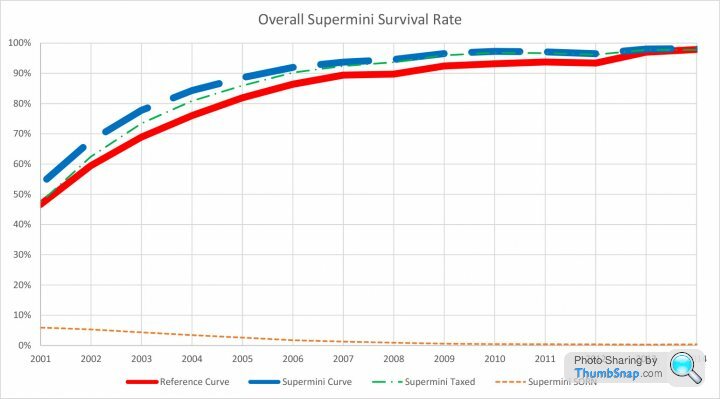
There is room for debate about the top five performers in the supermini segment of the PH survival stakes. I have taken the view that it is the VW Polo, the Skoda Fabia and the Fiat Panda that deserve a place in the top five, alongside the Honda Jazz and the Mini.

This is another strong performance by Honda, with the Jazz taking over from the Fabia in the survival rate stakes once cars’ tenth birthday has passed; however, as the Jazz was only introduced in 2002, the lack of 2001 data does not allow its long-term dominance to be confirmed. The Mini is exceptional in that it has a linear rate of decline, with no evidence (yet) of a steepening rate of decline with age, indeed the “BMW 0 Series’” 81.44% survival rate for 2001 cars establishes a new record in this work. It is conceivable that cars are mainly falling by the wayside as a result of accident damage. Even though the Mini survival rate has always been below that of the Jazz thus far, I will make the bold prediction that it will overtake the Jazz by the cars’ fifteenth birthdays: the Mini has a trendiness that the Jazz lacks, with its image as a grannymobile, and thus Minis are more likely to survive the need for big repair bills, in my view.
Moving on to the bottom three, which corresponds more with the theme of the thread:

Probably, it is unfair to lump the Renault Clio in with the Citroen Saxo/C2 and the Chevroloo Lanos/Kalos/Aveo, as its survival rate is not bad: hovering just above the survival reference line throughout. Indeed, the Renault Clio has a decidedly better survival rate than the Peugeot 106, and the last of the original line of Suzuki Swifts, but both of these escape inclusion as result of vastly improved performance by their successors. The Clio is a victim of the high standards set by others. There can be no doubt about the inclusion of the Saxo and the Chevroloo though. It is quite likely that the Saxo survival rates have been dragged down a bit by their ownership demographic, but no such excuse can be made for the Chevroloo, which achieves wretched survival rates. On this evidence, it is perhaps no surprise that Chevroloo has retreated from the European market.
In simple terms, a fourteen-year-old Lanos is almost four and half times as likely as a Mini to be feeding the furnaces.
Considering the survival record of each model in turn:
Citroen Saxo/C2/DS3: there is a noticeable increase in the survival rate with the introduction of the C2; however, a note of caution needs to exercised, given that the 2004 data is dominated by the C2 (over 94% of first registrations in this year), and it can be seen that the survival rate curve begins to dive sharply for 2005 and 2004 cars, passing below the reference survival curve for 2004 registered C2s. Hence, it might just be that becomes an increasing struggle to keep Citroens in this market segment on the road after their tenth birthdays. Nevertheless, it is still clear that C2s have a considerable survival advantage over Saxos: homing in on the 2004 data gives a survival rate of 51.2% for Saxos, against 75.3% for C2s. BUT it is only to be expected that the 2004 survival rate of Saxos would be low because of the way that the Government data is recorded, as the remaining stock was sold, many of the 2004 registered cars would be recorded as 2003 built cars, artificially supressing the 2004 survival rate. This effect can be seen on the graph that I prepared for an earlier post, repeated below for your convenience. It is too early to draw any conclusions on the relative survival rates of the C2 and the DS3.

This effect is why I like to look at continuous long-run for a single model line, as the artificial drop in survival rate for the outgoing model balances the artificial boost in survival rate of the incoming models, unless there is a radical change in volumes between the two models.
Daewoo Lanos/Kalos/Chevrolet Kalos/Aveo: I am not able to draw any conclusions about the relative survival rates of the Lanos and Kalos (2003 and 2004 registrations are dominated by the Kalos), other than to say that the 2002 Lanos seems to have an abnormally poor survival rate: the figure for 2001 registered Lanos are on the trend line of the Kalos, we do not know whether it is the 2001 or the 2002 data that is anomalous to this car’s survival trendline. There appears to be no difference in the survival trend line between the Kalos and the Aveo. This is a car that is set to disappear from our roads, and having had the misfortune to drive an Aveo on several occasions, I say good riddance!
Fiat Panda: a very creditable performance in the survival stakes by the new Panda. At present its survival rate is running consistently above its 500/Abarth twin, which I find slightly surprising; one imagines that this must be function of the ownership demographic: one has the impression that an average Fiat 500 owner is likely to be younger and more urban than a Panda owner. The Fiat Panda also has survival rates that are consistently above more mainstream options like the Fiesta and the Corsa. Given that the earliest examples were only some twelve years old in 2003, the shape of the critical part of the survival rate curve is not yet clear. Having said that, it would still need to fare badly indeed for its survival rate to fall below that of the Fiesta and the Corsa.
Fiat 500: this is too young to draw any proper conclusions about long term survival rate: we will need another four or five years of data to do this. I do not believe that we should get too excited about what appears to be a catastrophic decline in survival rates for 2007 Fiat 500s, as this relates to a sample of just 221 units that were first registered in 2007. Nevertheless, it does imply that there might be issues with very early 500s, given that in the circumstances of a small number of cars being registered at the end of the year, followed by a large number the next year (14,684), significant numbers of cars that were built in 2007 would have been registered in 2008. Because of the way that the registration data is recorded this should have shown up as a massive surge in the 2007 survival rate: I would have expected something well over 100%, not a drop from 93.8% in 2008 to 79.2% in 2007. So clearly something very odd is going on with these very early cars, but whatever it is, the issue rapidly disappears, with the survival rate reverting to the normal trend from 2008 onwards.
Ford Fiesta: the Fiesta Mk IV has a below average survival performance for the segment, only managing to exceed the Peugeot 106, Citroen Saxo, Suzuki Swift, and Daewoo Lanos, the ranks of Mk IV Fiestas are evidently thinning out considerably, if not in imminent danger of extinction. The survival rate of Mk V Fiestas is evidently better than the Mk IV, and is indeed had one of the top survival rates for twelve-year-old cars: its 82.7% survival rate is only exceeded by the Jazz, Mini, and the Polo. It will take another year or two’s data to quantify the extent of the improvement (the data for 2016 is scheduled for publication this April). The reason for the slight equivocation is that there is some evidence that 2002 and 2003 Mk Vs are entering a “death curve”, and we will need to get a better handle on the curve’s form to quantify the improvement over its predecessor. There are early signs that the Mk VI might have a further improvement in survival rate, but again several years more data would be needed to confirm this. The $64k question with the Fiesta is to whether inherent survivability has increased substantially since the Mk IV, or whether they become hard to keep alive much past twelve years old, April’s figures should give us some real pointers in this regard.
Honda Jazz: I have never owned a Honda, although this process of analysis is making me think that my next car should be a Honda, as I already own my own carpet slippers, I only need a pipe, and a trilby hat to qualify as a Honda driver! (More likely than me owning a baseball cap, let alone wearing it backwards, seemingly required to be a part of the alternative Honda demographic). Unlike the Civic, the Jazz does appear to be entering a “death curve”, starting at eleven years old, albeit from a higher level (nevertheless the survival rate for 2002 Jazzes is 85.4%, against the 2002 Civics 77.0%, reflecting the higher survival rates in the supermini class). So, that although the earliest First Generation Jazzes are beginning to die, the vast majority still survive, and it is apparent that they will be around for many years to come. Given that the survival rate is around the 98% mark at the transition between the First and Second Generation Jazzes, it is too early to say whether this will have any impact on survival rates. Naturally, it is likely to be some years before the transition between the Second and the Third Generation could be evaluated.
Hyundai Getz/i20: a very strong showing by this model line, to the extent that it had an arguable case to be in my top five. The Getz outperforms the Jazz survival rates as far out as 2006 (and even then, it only has a 0.03% survival rate disadvantage to 2006 Jazzes), being bested only by the Skoda Fabia and the Peugeot 107 (which arguably should not be part of a supermini analysis anyway) for 2007 cars. However, I believe that we should always be a little wary of making relative comparisons where the survival rate is very high, as to an extent, we are ranking the ownership profile and not the car. Although Getz survival rates begin to fall earlier than cars like the Mini, Jazz, Polo, and the Fiesta, the trend conforms to the reference survival curve trend, but some 10-15% above it. As the data only runs back to 2002, this is another car where another year’s worth of data will be particularly illuminating. Notwithstanding this, the survival rate for a car that could not be considered to be in way aspirational, and which represents an archetypical example of ‘white goods’ transportation, is extremely creditable. The early evidence suggests that the survival rate of the i20 might be better still, but again for a 2009 introduction, a few more years’ data would be needed to confirm this.
Mini: it is interesting that the reputation of early Minis to be more troublesome and costly to keep on the road than later cars does not appear to be having any noticeable impact on survival rates, which are consistently excellent. If anything, there is a suspicion that the survival rate might actually be dropping off with the R56 Mini, although these are little inconsistent for this model, at the moment. This is yet another case where we will need another year or two’s data for the position to become clearer. What we can say is that, inevitably, the original R50/R53 is going to have a classic status that its successor’s will not have, even before BMW’s ceaseless quest to make each generation of the Mini uglier, lardier, and less an object of desire than its predecessor, and thus will make owners likely to spend more on keeping ageing examples on the road. Whatever the truth of this, it is clear that even the earliest Minis are in no danger whatsoever of disappearing from our roads, and by the time that the cars get to fifteen to twenty years old are likely to be in a punch-up with the X350 Jaguar XJ for the title of best surviving non-exotic car overall. It is also clear that even if the R56 Mini does not have quite the same survival rate as the R50/R53 it is still likely to be very respectable, and above the class average.
Nissan Micra: a solid performance, with a survival rate that is always slightly better than the average of the market segment, and is just above the Toyota Yaris, for the most part, although K11 Micras are now beginning to die rapidly, at a rate that is faster than of the First Generation Yaris, dropping the survival rate below that of 2002 built Yaris. We can therefore predict that the K11 Micra is a car that is set to disappear from our roads shortly. The survival rate curve for the K12 Micra appears to be running around 2-3% below that of the K11, where they overlap in 2003, but what we do not know yet is whether the K12 will lurch into the same sharp decline in survival rate as the K11 when cars start to reach about twelve years old. This is another case where the new HMG data due out in April should provide a pointer. Naturally, it is too early to compare the survival rate of the K13 with is forebears.
Peugeot 106/107/108: The Peugeot 106 has a survival rate that will well below that of the 107, probably of the order of 20%, unless the 107 survival rate plummets unexpectedly. (The two-year gap between the 106 and the 107 makes exact qualification of the step-up in survival difficult at the moment, although this should be possible in April 2018). The 106’s survival rate is poor, being the fourth worst of the cars examined in this market segment. I would guess that rust has been the main killer of these, having had personal experience of one of these, gaining it at marriage, as sort of wedding anti-present, its foibles being incipient rust (on a fairly new car), electrical issues, coolant leaks, bad sunroof leaks, and my wife’s matchless ability to reduce it to its component parts, in something that appeared to be constructed from the steel equivalent of Bacofoil. (It was quite good fun to drive though, even though, as a diesel, I felt that the engine was too heavy for it, to the detriment of proper weight distribution). The 106 is therefore a car that is set to disappear from our roads, and indeed has already ceased to become a ubiquitous part of every street scene. There are some curiously low survival rates for 2012 and 2013 Peugeot 107s, at present I suggest that we will merely log it as odd, and perhaps a quirk brought about by a factor such as pre-registration or exports, if these rates start to drop away further in the coming years, then we can be certain that something is afoot.
Renault Clio: as discussed above, the Clio’s survival rate appears reasonable enough in isolation, but is overshadowed by the generally high standards in the class, and is consistently below the class average. The long overlap between the Clio 2 and the Clio 3 precludes comparative analysis: while I could disaggregate them for 2006-8 cars fairly easily, by splitting out the Campus models, I would question the extent to which this would give a true indication of inherent survivability, as the Clio 2s would be all ‘low rent’ versions, and as we have already seen sporty and up-market models tend to survive somewhat better. What we can say is that there appears to be no great discontinuity in survival rate between the Clio 2 and the Clio 3.
Skoda Fabia: for cars less than ten years old the Fabia tops the survival charts, after that it cannot match the age-defying survival antics of the Honda Jazz and the Mini, even though its rate of declining survival with age closely follows the trend of the reference curve, albeit some 14% (gross) consistently above it. The extent to which the high survival rate is a function of the ownership profile, or as a result of the inherent merits of the car, or as result of some other factor (see below) is one that we can debate (my personal view is a bit of all of these). Having studied the data, the apparent drop in the survival rate with the introduction of the Second Generation Fabia appears to be the result of an unnatural peak in the survival rate for 2006 built cars, which does not follow the trend to either side of it. If one disregards this point on the curve, it is not yet possible to determine any difference in the survival rate trends between the First and Second Generation Fabias. However, other questions still remain: why is there an unnatural blip in the 2006 survival rate, and why does the survival rate for 2006-2010 Fabias consistently run along and above 100% (101.4%, 98.6%, 99.3%, 101.6%, and 99.1%), before dropping to 97.3% and 97.4% in 2011 and 2012? One possible answer might lie in migration patterns to the UK, and that the boost in survival rates might be due to cars brought in by those settling in the UK from the Eastern part of Europe. Whatever the truth, or otherwise, of this supposition, there is clearly a distorting factor at play, that co-acts with the slight mismatch in collection methodology between the registration and the taxation/SORN datasets. Accordingly, although the Skoda Fabia is undoubtedly a car with an inherently high survival rate, its survival rate might be slightly boosted above its natural level in our analysis. But returning to the subject of the thread, it is clear that, although their ranks are thinning out, First Generation Skoda Fabias are likely to remain a feature of our roads for some years to come.
Suzuki Swift: the results for the Suzuki Swift have many similarities to those for the Peugeot 106/107/108 model line, in that a poor survival performance for the early models in the survey is followed by a hiatus, and then a new model, owing little to the former model, with a much higher survival rate. The Original Swift Second Generation’s survival rate is very poor, only exceeding the Daewoo Lanos for 2001 registered cars; furthermore it is clear that these are now dying off rapidly: we can predict that to all intents and purposes they will have disappeared from our roads within the next two to three years. In contrast, the survival rate of the New Swift Second Generation is vastly superior, it is probable that differential at thirteen years old will be something like 30% (gross), equivalent to a relative improvement in survival rate of over 60%. It should be noted that, unlike several of its rivals, the earliest of the new Swifts (2005) had not yet entered a steepening ‘death curve’ on the 2015 data, were this trend to continue, it is conceivable that New Swifts might become one of the top surviving fifteen-year-old superminis, again, this will be something to look for as more data is released in future years.
Toyota Yaris: the curves indicate that, at the point where the models meet in 2006, the First Generation has a higher survival rate than the Second Generation Yaris, by approx. 2.5%. How this will pan out as they age further remains to be seen. The Yaris’ survival curve is characterised by its inconsistency, in comparison to other cars that have sold in volume, which have much smoother and more consistent curves. Fundamentally, the survival rate is unremarkable, being slightly below to the class average, and exhibits the characteristic steepening ‘death curve’ once cars enter their second decade of life. What is truly bizarre is that this trend suddenly arrests for 2001 and 2002 cars. This is so marked that a 2001 Yaris has a survival rate second only to the Mini in this market segment. If we cast our minds back to our analysis of the survival rates of Luxury cars, we found that there was a sudden deterioration in the survival rates of post-2004 Lexus LSs; it is hard therefore to escape a suspicion that the post-2002 Yaris is harder to keep alive than earlier cars. If so, it would be expected that the survival rate of 2003 Yaris would drop below 2001/2 cars in the 2016 figures, due out in April: this will be interesting to watch out for. Having now seen the same trend for two products from the Toyota Group, it will also be interesting to see if it also found when we analyse further market sectors. At present, this is just a fairly strong question mark, if we see it in a third market segment then we have a clear pattern, particularly given the press furore of a few years’ back about alleged Toyota quality issues. It is clear however, that the First Generation Yaris is in no danger of disappearing from our roads.
Vauxhall Corsa: there are some indications that the survival rate of the Corsa D might be a little higher than that of the Corsa C, but it is too early to be certain. Overall, the Corsa’s survival rate is consistently a little below the average for the Supermini market segment, only exceeding it (by 1.95%) for 2001 cars. One might speculate that the relative improvement in survival rate for fourteen-year-old cars is as result of the popularity of these cars, and thus easier parts availability, and independent garages’ familiarity with the car. The Corsa’s survival performance bears many similarities to the other Vauxhall/Opel products analysed to date, being somewhat lacklustre, but not poor. If I write any more about the Corsa I am likely to die of boredom.
Volkswagen Polo: a good survival performance by the Polo, always comfortably above the average for the class, and always one of top three survivors of the cars considered, once the statistics become meaningful. Overall, it has the third best survival rate in the class, after the Honda Jazz and the Mini. Unlike other Volkswagen Group cars examined thus far, there is no sudden dive in survival rates from the early to mid-2000s, indeed there is a slight improvement in survival rate with the introduction of the Mk 4 Polo in 2002. I would suggest that this is because of the dateline of the model renewals, with the Polo never hitting “a Golf Mk 4 moment”: the Mk 3 Polo was heavily based on the Mk 3 Golf, which I would suggest was a nadir in the Golf line, and by the time that the Polo Mk 4 came out I would suggest that the moment of peak durability for the marque had passed.
The final graph compares the average for the class, with some of the cars that run closest to it for which full data exists.
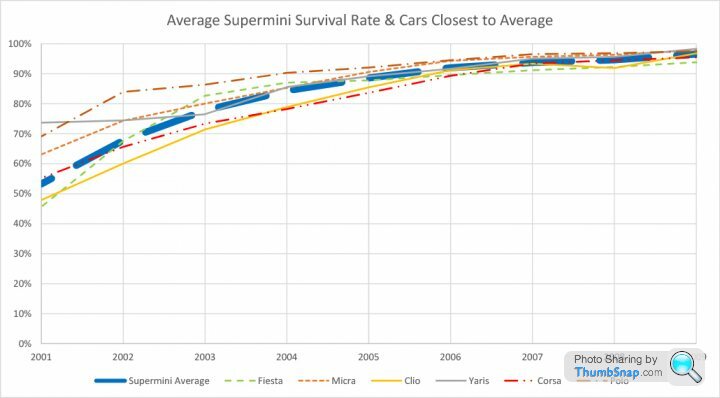
I hope that you found this interesting, as ever I would be pleased to debate this further, and to try and answer any further questions on the analysis.
As this is plainly going to be a long haul. I do not have any strong preference as to which of the market segments that I listed in an earlier post we do next – happy to go with the majority. Which market segment do you think that we should do next?
As promised, this is the competed supermini analysis, which supersedes my earlier post.
The sixteen models considered in this analysis are:
Citroen Saxo/C2/DS3: Saxo to 2004, C2 2003 to 2010, DS3 2010 onwards.
Daewoo Lanos/Kalos/Chevrolet Kalos/Aveo: to 2004, Kalos 2003 to 2008 (plus a few sold in 2009), Aveo 2008-2014 (abandoned market).
Fiat Panda: First Gen. to 2003 (but not officially sold after 1996), Second Gen. 2004 onwards (although there are a handful of 2003 cars).
Fiat 500/Abarth.
Ford Fiesta: Mk IV to 2002, Mk V 2002 to 2009, Mk VI 2008 onwards.
Honda Jazz: First Gen. 2001 to 2009, Second Gen.2009 to 2015, Third gen. 2015 onwards.
Hyundai Getz/i20: Getz to 2009, i20 from 2009 onwards.
Mini: R50/R53 to 2006, R56 2006 to 2014, F55/F56 2014 onwards.
Nissan Micra: K11 to 2003, K12 2003 to 2010, K13 2011 onwards.
Peugeot 106/107/108: 106 to 2003, 107 2005 to 2014, 108 2014 onwards.
Renault Clio: Clio 2 to 2008, Clio 3 2005 to 2013, Clio 4 2013 onwards.
Skoda Fabia: First Gen. to 2007, Second Gen. 2007 to 2015, Third Gen. 2015 onwards.
Suzuki Swift: Original Second Gen, to 2003, New Second Gen. 2005 to 2010, Third Gen. 2010 onwards.
Toyota Yaris: First Gen. to 2006, Second Gen 2006 to 2011, Third Gen 2011 onwards.
Vauxhall Corsa: Corsa C to 2006, Corsa D 2006 to 2015, Corsa E 2015 onwards.
Volkswagen Polo: Mark 3 to 2002, Mark 4 2002 to 2009, Mark 5 2009 onwards.
As previously, anything that I could identify as not being a hatchback has been removed from the data, in an attempt to keep the analysis on as an equivalent basis as is possible. As a result, I now know more about Mini special editions than I ever wanted to know! However, again as before, this process will not have been exhaustive: there are bound to be some convertibles, estates, coupes, etc. that still lurk in the data. In this respect identifying Fabia estates has been a particular issue.
Categorisation is a bit of issue for me in the supermini sector, given the overlap with the class below, and with the class above. One of the most obvious examples of this is in the Peugeot line, where, in my view, the 106 was unquestionably a supermini, whereas its direct lineal successors can more properly be regarded as being in the class below; one thus has decide whether to follow the model line, or to take a strict view of what constitutes a supermini. Accordingly, this piece of work is a highly personal view of what constitutes a supermini in the context of this analysis. My apologies if what I have done does not correspond to your view.
Given that graphs with more than eight lines become difficult to read, the initial graphical analysis splits the cars into two groups of cars (marque names A-M, and N-Z). Where appropriate, the top and bottom performing few models are then presented together for comparison.
As is customary we will look at the numbers of first registrations, for the two groups.


I believe these two graphs to be self-explanatory.
As the majority of the models in the supermini market segment have been included, we can make a reasonably close estimate of the total number of supermini hatchbacks registered in each year, by adding the figures for the sixteen models considered together:

We can see that the number of supermini hatchbacks sold is broadly similar in 2015 to what it was in 2001 (increasing by 5.1% over the period). In detail, sales in the segment declined from 2003 to 2011, but have increased sharply and progressively since 2011, increasing by 28.4% between 2011 and 2015. I believe that we can ascribe this to two factors: firstly, the increasing size and comfort of cars in this class, capturing sales from the family hatchback sector; and secondly, the growth of ‘fashion statement’ cars in the sector, such as the Mini and Fiat 500. The second argument is a little more tenuous though, given that Mini sales have been fairly flat across the period, a spike in 2015 notwithstanding.
Moving onto survival rates the graphs for the 2001 to 2014 period for the two groups are as follows:


In certain years, when new, some of these cars achieve survival rates of slightly over 100% (101.4% maximum). Although I have already discussed some of the reasons behind this, I thought that it might be helpful to re-articulate and to expand on this apparently impossible phenomenon. There are two main reasons, and several second order reasons, for this. The first of the main reasons is that the datasets relating to vehicles that are taxed and SORNed relate to the United Kingdom as a whole, whereas those pertaining to registrations relate to Great Britain only, and is therefore an inherently smaller pool of vehicles. The second main reason is that new cars are identified by year of registration, whereas taxed and SORNed cars are identified by year of manufacture: it is inevitable that some cars are manufactured late one year and registered the next, as sales rates are not flat, this introduces anomalies where the year of manufacture is properly recorded. Neither of these factors greatly distort the figures (we can see that the total impact of all the distorting factors is less than 3%), and are theoretically the same for all cars, although in practice differential impacts can be experienced for low sales volume cars that are exceptionally popular in Northern Ireland, for models that have large unsold inventories, and for those with longer distribution chains (e.g. from the Far East). Lesser impacts are caused by pre-registration of cars, which tends to bulk numbers of registrations in the years where it is most prevalent, and by importation of older cars into the British registration system.
Pre-registration is an interesting issue: in the case of almost all of these cars the SORN rate for 2015 cars is some way above that for 2014 cars, and in the years leading up to this. It should be stressed that there are other possible explanations, other than pre-registration, for this phenomenon; however, I still find the following first year SORN rates interesting as a possible indicator of who it appears might be maintaining market share artificially through pre-registrations:
Citroen DS3: 0.51%
Fiat Panda: 0.05%
Fiat 500/Abarth: 0.58%
Ford Fiesta: 0.97%
Honda Jazz: 0.40%
Hyundai i20: 0.11%
Mini: 0.61%
Nissan Micra: 0.31%
Peugeot 108: 0.66%
Renault Clio: 0.22%
Skoda Fabia: 0.52%
Suzuki Swift: 0.41%
Toyota Yaris: 0.14%
Vauxhall Corsa: 0.32%
Volkswagen Polo: 0.30%
In the context of the current thread, the issue is whether registration above the initial natural demand level is likely to affect the long-term survival rate, and whether this would be confined to just the models in question, or would have wider impacts throughout the market segment. This is something that we can all pontificate about, but I cannot give you any firm evidence on the basis of the data currently available. Personally, I suspect that the answer will be driven by a mix of exogenous and endogenous factors, not all of which are foreseeable. (Although some might be foreseeable, e.g. will the bloated and gopping F55/F56 Mini be as appealing to purchasers of a female persuasion as the cute R50/R53 Mini is, a few years down the line?)
As ever, the 2001 to 2009 portion of the survival curves are the most interesting part:


As one would expect, survival rates in the market segment tend to be above the reference survival curve, given that we are talking about a type of vehicle that has strong second-hand demand, as a second family car, and as a point of entry to the car market, and also one where the cost of repairs tends to be lower than average.

There is room for debate about the top five performers in the supermini segment of the PH survival stakes. I have taken the view that it is the VW Polo, the Skoda Fabia and the Fiat Panda that deserve a place in the top five, alongside the Honda Jazz and the Mini.

This is another strong performance by Honda, with the Jazz taking over from the Fabia in the survival rate stakes once cars’ tenth birthday has passed; however, as the Jazz was only introduced in 2002, the lack of 2001 data does not allow its long-term dominance to be confirmed. The Mini is exceptional in that it has a linear rate of decline, with no evidence (yet) of a steepening rate of decline with age, indeed the “BMW 0 Series’” 81.44% survival rate for 2001 cars establishes a new record in this work. It is conceivable that cars are mainly falling by the wayside as a result of accident damage. Even though the Mini survival rate has always been below that of the Jazz thus far, I will make the bold prediction that it will overtake the Jazz by the cars’ fifteenth birthdays: the Mini has a trendiness that the Jazz lacks, with its image as a grannymobile, and thus Minis are more likely to survive the need for big repair bills, in my view.
Moving on to the bottom three, which corresponds more with the theme of the thread:

Probably, it is unfair to lump the Renault Clio in with the Citroen Saxo/C2 and the Chevroloo Lanos/Kalos/Aveo, as its survival rate is not bad: hovering just above the survival reference line throughout. Indeed, the Renault Clio has a decidedly better survival rate than the Peugeot 106, and the last of the original line of Suzuki Swifts, but both of these escape inclusion as result of vastly improved performance by their successors. The Clio is a victim of the high standards set by others. There can be no doubt about the inclusion of the Saxo and the Chevroloo though. It is quite likely that the Saxo survival rates have been dragged down a bit by their ownership demographic, but no such excuse can be made for the Chevroloo, which achieves wretched survival rates. On this evidence, it is perhaps no surprise that Chevroloo has retreated from the European market.
In simple terms, a fourteen-year-old Lanos is almost four and half times as likely as a Mini to be feeding the furnaces.
Considering the survival record of each model in turn:
Citroen Saxo/C2/DS3: there is a noticeable increase in the survival rate with the introduction of the C2; however, a note of caution needs to exercised, given that the 2004 data is dominated by the C2 (over 94% of first registrations in this year), and it can be seen that the survival rate curve begins to dive sharply for 2005 and 2004 cars, passing below the reference survival curve for 2004 registered C2s. Hence, it might just be that becomes an increasing struggle to keep Citroens in this market segment on the road after their tenth birthdays. Nevertheless, it is still clear that C2s have a considerable survival advantage over Saxos: homing in on the 2004 data gives a survival rate of 51.2% for Saxos, against 75.3% for C2s. BUT it is only to be expected that the 2004 survival rate of Saxos would be low because of the way that the Government data is recorded, as the remaining stock was sold, many of the 2004 registered cars would be recorded as 2003 built cars, artificially supressing the 2004 survival rate. This effect can be seen on the graph that I prepared for an earlier post, repeated below for your convenience. It is too early to draw any conclusions on the relative survival rates of the C2 and the DS3.

This effect is why I like to look at continuous long-run for a single model line, as the artificial drop in survival rate for the outgoing model balances the artificial boost in survival rate of the incoming models, unless there is a radical change in volumes between the two models.
Daewoo Lanos/Kalos/Chevrolet Kalos/Aveo: I am not able to draw any conclusions about the relative survival rates of the Lanos and Kalos (2003 and 2004 registrations are dominated by the Kalos), other than to say that the 2002 Lanos seems to have an abnormally poor survival rate: the figure for 2001 registered Lanos are on the trend line of the Kalos, we do not know whether it is the 2001 or the 2002 data that is anomalous to this car’s survival trendline. There appears to be no difference in the survival trend line between the Kalos and the Aveo. This is a car that is set to disappear from our roads, and having had the misfortune to drive an Aveo on several occasions, I say good riddance!
Fiat Panda: a very creditable performance in the survival stakes by the new Panda. At present its survival rate is running consistently above its 500/Abarth twin, which I find slightly surprising; one imagines that this must be function of the ownership demographic: one has the impression that an average Fiat 500 owner is likely to be younger and more urban than a Panda owner. The Fiat Panda also has survival rates that are consistently above more mainstream options like the Fiesta and the Corsa. Given that the earliest examples were only some twelve years old in 2003, the shape of the critical part of the survival rate curve is not yet clear. Having said that, it would still need to fare badly indeed for its survival rate to fall below that of the Fiesta and the Corsa.
Fiat 500: this is too young to draw any proper conclusions about long term survival rate: we will need another four or five years of data to do this. I do not believe that we should get too excited about what appears to be a catastrophic decline in survival rates for 2007 Fiat 500s, as this relates to a sample of just 221 units that were first registered in 2007. Nevertheless, it does imply that there might be issues with very early 500s, given that in the circumstances of a small number of cars being registered at the end of the year, followed by a large number the next year (14,684), significant numbers of cars that were built in 2007 would have been registered in 2008. Because of the way that the registration data is recorded this should have shown up as a massive surge in the 2007 survival rate: I would have expected something well over 100%, not a drop from 93.8% in 2008 to 79.2% in 2007. So clearly something very odd is going on with these very early cars, but whatever it is, the issue rapidly disappears, with the survival rate reverting to the normal trend from 2008 onwards.
Ford Fiesta: the Fiesta Mk IV has a below average survival performance for the segment, only managing to exceed the Peugeot 106, Citroen Saxo, Suzuki Swift, and Daewoo Lanos, the ranks of Mk IV Fiestas are evidently thinning out considerably, if not in imminent danger of extinction. The survival rate of Mk V Fiestas is evidently better than the Mk IV, and is indeed had one of the top survival rates for twelve-year-old cars: its 82.7% survival rate is only exceeded by the Jazz, Mini, and the Polo. It will take another year or two’s data to quantify the extent of the improvement (the data for 2016 is scheduled for publication this April). The reason for the slight equivocation is that there is some evidence that 2002 and 2003 Mk Vs are entering a “death curve”, and we will need to get a better handle on the curve’s form to quantify the improvement over its predecessor. There are early signs that the Mk VI might have a further improvement in survival rate, but again several years more data would be needed to confirm this. The $64k question with the Fiesta is to whether inherent survivability has increased substantially since the Mk IV, or whether they become hard to keep alive much past twelve years old, April’s figures should give us some real pointers in this regard.
Honda Jazz: I have never owned a Honda, although this process of analysis is making me think that my next car should be a Honda, as I already own my own carpet slippers, I only need a pipe, and a trilby hat to qualify as a Honda driver! (More likely than me owning a baseball cap, let alone wearing it backwards, seemingly required to be a part of the alternative Honda demographic). Unlike the Civic, the Jazz does appear to be entering a “death curve”, starting at eleven years old, albeit from a higher level (nevertheless the survival rate for 2002 Jazzes is 85.4%, against the 2002 Civics 77.0%, reflecting the higher survival rates in the supermini class). So, that although the earliest First Generation Jazzes are beginning to die, the vast majority still survive, and it is apparent that they will be around for many years to come. Given that the survival rate is around the 98% mark at the transition between the First and Second Generation Jazzes, it is too early to say whether this will have any impact on survival rates. Naturally, it is likely to be some years before the transition between the Second and the Third Generation could be evaluated.
Hyundai Getz/i20: a very strong showing by this model line, to the extent that it had an arguable case to be in my top five. The Getz outperforms the Jazz survival rates as far out as 2006 (and even then, it only has a 0.03% survival rate disadvantage to 2006 Jazzes), being bested only by the Skoda Fabia and the Peugeot 107 (which arguably should not be part of a supermini analysis anyway) for 2007 cars. However, I believe that we should always be a little wary of making relative comparisons where the survival rate is very high, as to an extent, we are ranking the ownership profile and not the car. Although Getz survival rates begin to fall earlier than cars like the Mini, Jazz, Polo, and the Fiesta, the trend conforms to the reference survival curve trend, but some 10-15% above it. As the data only runs back to 2002, this is another car where another year’s worth of data will be particularly illuminating. Notwithstanding this, the survival rate for a car that could not be considered to be in way aspirational, and which represents an archetypical example of ‘white goods’ transportation, is extremely creditable. The early evidence suggests that the survival rate of the i20 might be better still, but again for a 2009 introduction, a few more years’ data would be needed to confirm this.
Mini: it is interesting that the reputation of early Minis to be more troublesome and costly to keep on the road than later cars does not appear to be having any noticeable impact on survival rates, which are consistently excellent. If anything, there is a suspicion that the survival rate might actually be dropping off with the R56 Mini, although these are little inconsistent for this model, at the moment. This is yet another case where we will need another year or two’s data for the position to become clearer. What we can say is that, inevitably, the original R50/R53 is going to have a classic status that its successor’s will not have, even before BMW’s ceaseless quest to make each generation of the Mini uglier, lardier, and less an object of desire than its predecessor, and thus will make owners likely to spend more on keeping ageing examples on the road. Whatever the truth of this, it is clear that even the earliest Minis are in no danger whatsoever of disappearing from our roads, and by the time that the cars get to fifteen to twenty years old are likely to be in a punch-up with the X350 Jaguar XJ for the title of best surviving non-exotic car overall. It is also clear that even if the R56 Mini does not have quite the same survival rate as the R50/R53 it is still likely to be very respectable, and above the class average.
Nissan Micra: a solid performance, with a survival rate that is always slightly better than the average of the market segment, and is just above the Toyota Yaris, for the most part, although K11 Micras are now beginning to die rapidly, at a rate that is faster than of the First Generation Yaris, dropping the survival rate below that of 2002 built Yaris. We can therefore predict that the K11 Micra is a car that is set to disappear from our roads shortly. The survival rate curve for the K12 Micra appears to be running around 2-3% below that of the K11, where they overlap in 2003, but what we do not know yet is whether the K12 will lurch into the same sharp decline in survival rate as the K11 when cars start to reach about twelve years old. This is another case where the new HMG data due out in April should provide a pointer. Naturally, it is too early to compare the survival rate of the K13 with is forebears.
Peugeot 106/107/108: The Peugeot 106 has a survival rate that will well below that of the 107, probably of the order of 20%, unless the 107 survival rate plummets unexpectedly. (The two-year gap between the 106 and the 107 makes exact qualification of the step-up in survival difficult at the moment, although this should be possible in April 2018). The 106’s survival rate is poor, being the fourth worst of the cars examined in this market segment. I would guess that rust has been the main killer of these, having had personal experience of one of these, gaining it at marriage, as sort of wedding anti-present, its foibles being incipient rust (on a fairly new car), electrical issues, coolant leaks, bad sunroof leaks, and my wife’s matchless ability to reduce it to its component parts, in something that appeared to be constructed from the steel equivalent of Bacofoil. (It was quite good fun to drive though, even though, as a diesel, I felt that the engine was too heavy for it, to the detriment of proper weight distribution). The 106 is therefore a car that is set to disappear from our roads, and indeed has already ceased to become a ubiquitous part of every street scene. There are some curiously low survival rates for 2012 and 2013 Peugeot 107s, at present I suggest that we will merely log it as odd, and perhaps a quirk brought about by a factor such as pre-registration or exports, if these rates start to drop away further in the coming years, then we can be certain that something is afoot.
Renault Clio: as discussed above, the Clio’s survival rate appears reasonable enough in isolation, but is overshadowed by the generally high standards in the class, and is consistently below the class average. The long overlap between the Clio 2 and the Clio 3 precludes comparative analysis: while I could disaggregate them for 2006-8 cars fairly easily, by splitting out the Campus models, I would question the extent to which this would give a true indication of inherent survivability, as the Clio 2s would be all ‘low rent’ versions, and as we have already seen sporty and up-market models tend to survive somewhat better. What we can say is that there appears to be no great discontinuity in survival rate between the Clio 2 and the Clio 3.
Skoda Fabia: for cars less than ten years old the Fabia tops the survival charts, after that it cannot match the age-defying survival antics of the Honda Jazz and the Mini, even though its rate of declining survival with age closely follows the trend of the reference curve, albeit some 14% (gross) consistently above it. The extent to which the high survival rate is a function of the ownership profile, or as a result of the inherent merits of the car, or as result of some other factor (see below) is one that we can debate (my personal view is a bit of all of these). Having studied the data, the apparent drop in the survival rate with the introduction of the Second Generation Fabia appears to be the result of an unnatural peak in the survival rate for 2006 built cars, which does not follow the trend to either side of it. If one disregards this point on the curve, it is not yet possible to determine any difference in the survival rate trends between the First and Second Generation Fabias. However, other questions still remain: why is there an unnatural blip in the 2006 survival rate, and why does the survival rate for 2006-2010 Fabias consistently run along and above 100% (101.4%, 98.6%, 99.3%, 101.6%, and 99.1%), before dropping to 97.3% and 97.4% in 2011 and 2012? One possible answer might lie in migration patterns to the UK, and that the boost in survival rates might be due to cars brought in by those settling in the UK from the Eastern part of Europe. Whatever the truth, or otherwise, of this supposition, there is clearly a distorting factor at play, that co-acts with the slight mismatch in collection methodology between the registration and the taxation/SORN datasets. Accordingly, although the Skoda Fabia is undoubtedly a car with an inherently high survival rate, its survival rate might be slightly boosted above its natural level in our analysis. But returning to the subject of the thread, it is clear that, although their ranks are thinning out, First Generation Skoda Fabias are likely to remain a feature of our roads for some years to come.
Suzuki Swift: the results for the Suzuki Swift have many similarities to those for the Peugeot 106/107/108 model line, in that a poor survival performance for the early models in the survey is followed by a hiatus, and then a new model, owing little to the former model, with a much higher survival rate. The Original Swift Second Generation’s survival rate is very poor, only exceeding the Daewoo Lanos for 2001 registered cars; furthermore it is clear that these are now dying off rapidly: we can predict that to all intents and purposes they will have disappeared from our roads within the next two to three years. In contrast, the survival rate of the New Swift Second Generation is vastly superior, it is probable that differential at thirteen years old will be something like 30% (gross), equivalent to a relative improvement in survival rate of over 60%. It should be noted that, unlike several of its rivals, the earliest of the new Swifts (2005) had not yet entered a steepening ‘death curve’ on the 2015 data, were this trend to continue, it is conceivable that New Swifts might become one of the top surviving fifteen-year-old superminis, again, this will be something to look for as more data is released in future years.
Toyota Yaris: the curves indicate that, at the point where the models meet in 2006, the First Generation has a higher survival rate than the Second Generation Yaris, by approx. 2.5%. How this will pan out as they age further remains to be seen. The Yaris’ survival curve is characterised by its inconsistency, in comparison to other cars that have sold in volume, which have much smoother and more consistent curves. Fundamentally, the survival rate is unremarkable, being slightly below to the class average, and exhibits the characteristic steepening ‘death curve’ once cars enter their second decade of life. What is truly bizarre is that this trend suddenly arrests for 2001 and 2002 cars. This is so marked that a 2001 Yaris has a survival rate second only to the Mini in this market segment. If we cast our minds back to our analysis of the survival rates of Luxury cars, we found that there was a sudden deterioration in the survival rates of post-2004 Lexus LSs; it is hard therefore to escape a suspicion that the post-2002 Yaris is harder to keep alive than earlier cars. If so, it would be expected that the survival rate of 2003 Yaris would drop below 2001/2 cars in the 2016 figures, due out in April: this will be interesting to watch out for. Having now seen the same trend for two products from the Toyota Group, it will also be interesting to see if it also found when we analyse further market sectors. At present, this is just a fairly strong question mark, if we see it in a third market segment then we have a clear pattern, particularly given the press furore of a few years’ back about alleged Toyota quality issues. It is clear however, that the First Generation Yaris is in no danger of disappearing from our roads.
Vauxhall Corsa: there are some indications that the survival rate of the Corsa D might be a little higher than that of the Corsa C, but it is too early to be certain. Overall, the Corsa’s survival rate is consistently a little below the average for the Supermini market segment, only exceeding it (by 1.95%) for 2001 cars. One might speculate that the relative improvement in survival rate for fourteen-year-old cars is as result of the popularity of these cars, and thus easier parts availability, and independent garages’ familiarity with the car. The Corsa’s survival performance bears many similarities to the other Vauxhall/Opel products analysed to date, being somewhat lacklustre, but not poor. If I write any more about the Corsa I am likely to die of boredom.
Volkswagen Polo: a good survival performance by the Polo, always comfortably above the average for the class, and always one of top three survivors of the cars considered, once the statistics become meaningful. Overall, it has the third best survival rate in the class, after the Honda Jazz and the Mini. Unlike other Volkswagen Group cars examined thus far, there is no sudden dive in survival rates from the early to mid-2000s, indeed there is a slight improvement in survival rate with the introduction of the Mk 4 Polo in 2002. I would suggest that this is because of the dateline of the model renewals, with the Polo never hitting “a Golf Mk 4 moment”: the Mk 3 Polo was heavily based on the Mk 3 Golf, which I would suggest was a nadir in the Golf line, and by the time that the Polo Mk 4 came out I would suggest that the moment of peak durability for the marque had passed.
The final graph compares the average for the class, with some of the cars that run closest to it for which full data exists.

I hope that you found this interesting, as ever I would be pleased to debate this further, and to try and answer any further questions on the analysis.
As this is plainly going to be a long haul. I do not have any strong preference as to which of the market segments that I listed in an earlier post we do next – happy to go with the majority. Which market segment do you think that we should do next?
Hub said:
Amazing analysis as usual!
I see you went foe the Peugeot 106 but not the 206. My perception is that they (the 206) are still everywhere in various states of rattiness - but that might be because they sold so many of them for so long!
Thanks. I see you went foe the Peugeot 106 but not the 206. My perception is that they (the 206) are still everywhere in various states of rattiness - but that might be because they sold so many of them for so long!
The Peugeot range can be difficult to fit, as Peugeot has always had a bit of a tendency to size cars between the established groups, whether one can ascribe this to canny marketing or to Gallic singularity is a matter of opinion. The Peugeot 205 (the lineal predecessor of the 206) is a classic case being a bit bigger than a supermini (when new, not now), but smaller than a family hatchback. I would regard the 104 - 106 line as the supermini line in the range. I accept that I could have chosen the 206 and its successors, as the supermini line - certainly its lineal successors fit better than the 106s, but is a decision that I could have called either way.
This also highlights the issue of size creep in the market segments, as manufacturers tend to grow each successive generation as its clientele age, grow fatter, and accumulate more family members. If anyone launched the Peugeot 104 these days it would be regarded as a tiny city car and not as a the supermini that it unquestionably was in 1974 (I think). This has then led to the creation of new market segments below smaller ones as they grow - it would have been inconceivable for there to be model under the Mk1 VW Polo, but as the Polo grew so the space for the Lupo was created.
Edited by Car_Nut on Tuesday 7th February 13:34
Car_Nut said:
The Peugeot range can be difficult to fit, as Peugeot has always had a bit of a tendency to size cars between the established groups, whether one can ascribe this to canny marketing or to Gallic singularity is a matter of opinion. The Peugeot 205 (the lineal predecessor of the 206) is a classic case being a bit bigger than a supermini (when new, not now), but smaller than a family hatchback.
Not sure about that. I remember a Fiesta I owned being exactly the same size as a 205, so I checked. The Mk2 XR2 was apparently 3718x1580x1326mm (LWH) against a 205 GTi at 3705x1572x1355, so close to identical other than 1" taller. Tiny cars by current standards though, as you say. Edited by Car_Nut on Tuesday 7th February 13:34
battered said:
Car_Nut said:
The Peugeot range can be difficult to fit, as Peugeot has always had a bit of a tendency to size cars between the established groups, whether one can ascribe this to canny marketing or to Gallic singularity is a matter of opinion. The Peugeot 205 (the lineal predecessor of the 206) is a classic case being a bit bigger than a supermini (when new, not now), but smaller than a family hatchback.
Not sure about that. I remember a Fiesta I owned being exactly the same size as a 205, so I checked. The Mk2 XR2 was apparently 3718x1580x1326mm (LWH) against a 205 GTi at 3705x1572x1355, so close to identical other than 1" taller. Tiny cars by current standards though, as you say. Edited by Car_Nut on Tuesday 7th February 13:34
Fiesta MkII: 2286 mm
Polo Mk 2: 2335mm
Nova: 2343 mm
Peugeot 205: 2418mm
Escort Mk3: 2393mm
Golf Mk2: 2470mm
But fundamentally I agree absolutely that I could have selected the 20x line rather than the 10x line as the Peugeot supermini line, and in many ways that would be a better fit. Accordingly, it would be churlish of me not to give you the survival curve for the 206/207/208 line, from which I have removed all CC and SW models, for consistency:
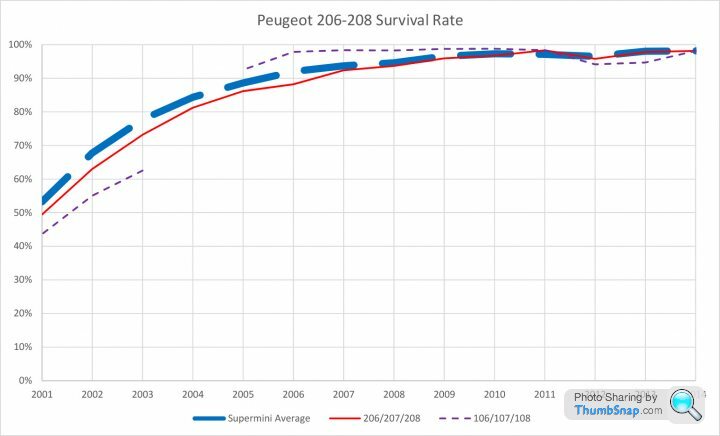
But the penance for you my friend, Battered, is to put the responsibility for the write up at your feet! (The model overlap years in the registration data are 2006 & 2012).
Car_Nut said:
I could of course hit you with some rival statistics, wheelbase:
Fiesta MkII: 2286 mm
Polo Mk 2: 2335mm
Nova: 2343 mm
Peugeot 205: 2418mm
Escort Mk3: 2393mm
Golf Mk2: 2470mm
But fundamentally I agree absolutely that I could have selected the 20x line rather than the 10x line as the Peugeot supermini line, and in many ways that would be a better fit. Accordingly, it would be churlish of me not to give you the survival curve for the 206/207/208 line, from which I have removed all CC and SW models, for consistency:

But the penance for you my friend, Battered, is to put the responsibility for the write up at your feet! (The model overlap years in the registration data are 2006 & 2012).
The 205 was bigger than the 106, for sure. They were sold alongside each other for a time, and then the 206 was introduced alongside the 106 ph2 after the 205 had died off.Fiesta MkII: 2286 mm
Polo Mk 2: 2335mm
Nova: 2343 mm
Peugeot 205: 2418mm
Escort Mk3: 2393mm
Golf Mk2: 2470mm
But fundamentally I agree absolutely that I could have selected the 20x line rather than the 10x line as the Peugeot supermini line, and in many ways that would be a better fit. Accordingly, it would be churlish of me not to give you the survival curve for the 206/207/208 line, from which I have removed all CC and SW models, for consistency:

But the penance for you my friend, Battered, is to put the responsibility for the write up at your feet! (The model overlap years in the registration data are 2006 & 2012).
Citroen used to do the same thing, regards size. The Visa was 205-sized (though not that related under the skin, and their tiny car was the LNA (a Peugeot 104/Talbot Samba with chevrons).
It carried on with the GS and BX too. In fact, they had a chance to reset things with the BX because it was launched just after the Sierra, and a year or so after the Cavalier mk2, but they went with the same formula of pitching the car halfway between rivals. The idea with the BX was that the 1.4, more basic models would compete with the Escort/Astra class, and the 1.6/1.9 models would compete with the Sierra class. Despite being smaller externally, they were roomier than the Sierra and many of the rivals, and I'm pretty sure the same is true of the 205 compared with some larger rivals.
Eventually they ditched that idea when the BX died off, and went with the regular size classes with the ZX (Astra/Escort) and Xantia (Cavalier/Mondeo).
The French were always pretty good at picking their market segments.
So can we conclude that cars which tend to be bought by older more careful owners like the Jazz and Getz understandably do better than Fiestas and Corsas which are bought by younger buyers and then trashed/crashed?
My wife has a 2005 Fiesta ST and its a really solid reliable little car. No rust, cheap to run, doesn't go wrong. I seem to recall that in independent research done by one of the warranty companies, the 2002-08 Fiesta's reliability record matched that of the Mazda MX-5 of the period, so it doesn't seem they are unreliable, yet they disappear off the roads much faster than, say the Skoda, Hyundai, Honda.....
My wife has a 2005 Fiesta ST and its a really solid reliable little car. No rust, cheap to run, doesn't go wrong. I seem to recall that in independent research done by one of the warranty companies, the 2002-08 Fiesta's reliability record matched that of the Mazda MX-5 of the period, so it doesn't seem they are unreliable, yet they disappear off the roads much faster than, say the Skoda, Hyundai, Honda.....
greenarrow said:
So can we conclude that cars which tend to be bought by older more careful owners like the Jazz and Getz understandably do better than Fiestas and Corsas which are bought by younger buyers and then trashed/crashed?
My wife has a 2005 Fiesta ST and its a really solid reliable little car. No rust, cheap to run, doesn't go wrong. I seem to recall that in independent research done by one of the warranty companies, the 2002-08 Fiesta's reliability record matched that of the Mazda MX-5 of the period, so it doesn't seem they are unreliable, yet they disappear off the roads much faster than, say the Skoda, Hyundai, Honda.....
While there is undoubtedly truth in the statement that cars that tend to be bought my more mature drivers have a survival advantage, at least in their early years, I think that this is only the case for the Fiesta to a limited extent (which after all also a strong following amongst the more careful type of driver) - as I said in the analysis the Mk V's survival rate is pretty good, as soon as we get out to about twelve years it is outliving the Getz. What then happens is that the survival rate plunges: in all probability this is because the MK IV has become inherently more difficult to keep on the road, either through design, parts availability, or lack of love. Although, of course, the Mk V might also start to enter a steep 'death curve' after twelve years - this should become clear one way or the other when the 2016 figures are published in April. My money is on the Mk V surviving better. In the case of the Jazz, I suspect that the Fiesta just lacks its inherent survivability, as the gap is very large.My wife has a 2005 Fiesta ST and its a really solid reliable little car. No rust, cheap to run, doesn't go wrong. I seem to recall that in independent research done by one of the warranty companies, the 2002-08 Fiesta's reliability record matched that of the Mazda MX-5 of the period, so it doesn't seem they are unreliable, yet they disappear off the roads much faster than, say the Skoda, Hyundai, Honda.....
Adding the data for the Peugeot 206/207/208 made me conscious that we have not done any work on the survival advantages of cabriolets, nor for small estates. These are particularly easy to spot in the Peugeot data.
To date, we have only looked at differential survival rates for estate cars over saloons for a couple of discrete 2003 Volvo S40/V40 and BMW 3 Series models, where if you recall, we found that the estate versions had a survival rate varying between 2.5% and 9% higher than the saloon variant, and that their probability of being taxed is even higher, at between 5% and 16%. I therefore thought that it would be interesting to look at a smaller estate and one based on, an inherently more versatile, hatchback.
As usual, let’s start by looking at the numbers registered:
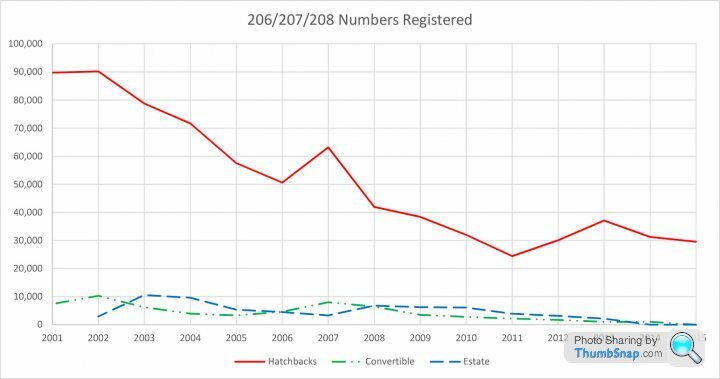
This equates to the following shares for the model:
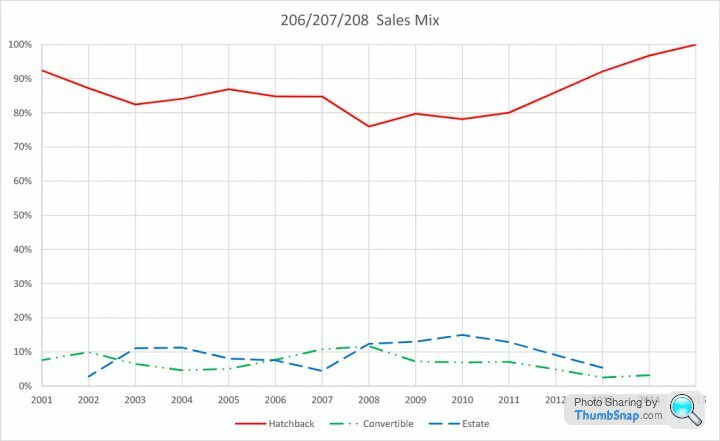
In looking at this we need to be conscious that the specialist variants were not always replaced at the same time as the core model. For, example, the 206 cabriolet continued on after the introduction of the 207, likewise the 207 estate continued after introduction of the 208. Note that the 208 is hatchback only.
There are no surprises about the differential in survival rates.
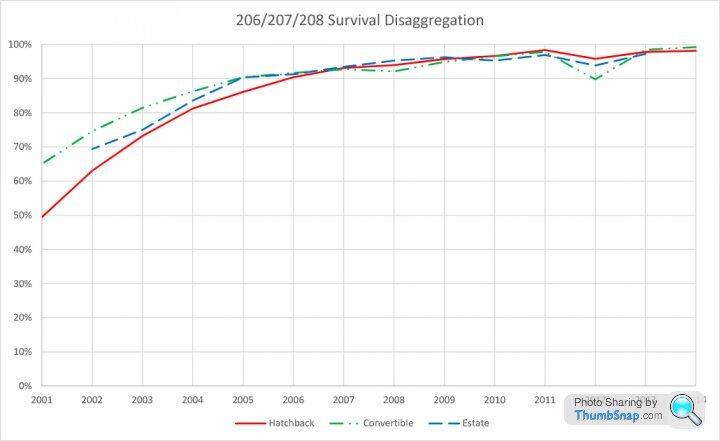
From this we can derive the survival rate advantage for estates and cabriolets. I think that the form of the cabriolet curve is plain enough, but as we are talking about processed data on a modest-sized dataset subject to multiple variables the form of the estate curve is less clear, so I have had to put a trend line through it.
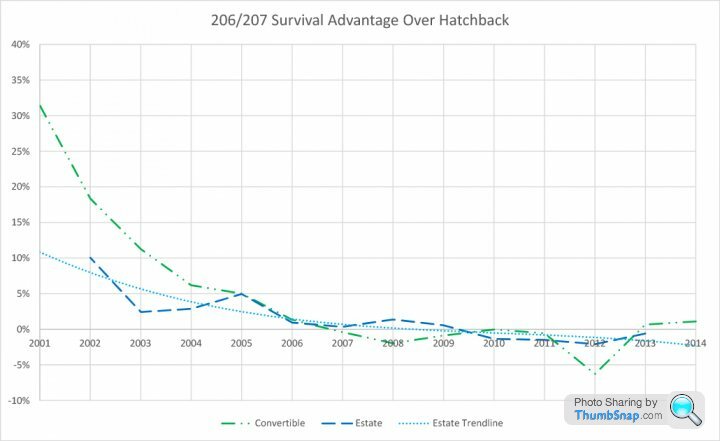
If we look at the probability that a surviving vehicle is taxed, again there are no surprises, and we get the following curve (please note that this has an exaggerated scale to show the differences):
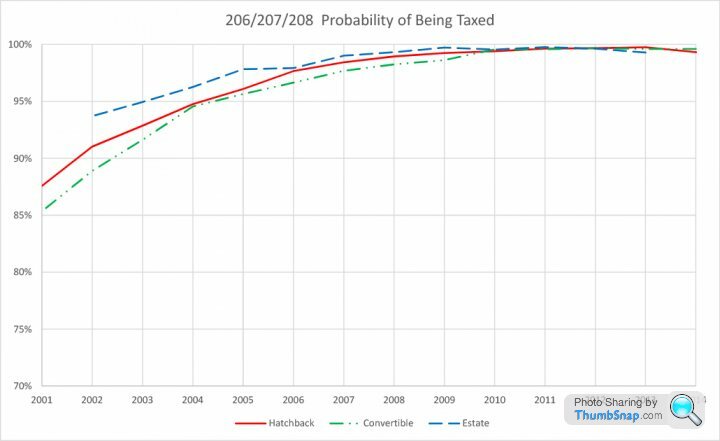
Does anyone have a preference for which market segment we do next?
To date, we have only looked at differential survival rates for estate cars over saloons for a couple of discrete 2003 Volvo S40/V40 and BMW 3 Series models, where if you recall, we found that the estate versions had a survival rate varying between 2.5% and 9% higher than the saloon variant, and that their probability of being taxed is even higher, at between 5% and 16%. I therefore thought that it would be interesting to look at a smaller estate and one based on, an inherently more versatile, hatchback.
As usual, let’s start by looking at the numbers registered:

This equates to the following shares for the model:

In looking at this we need to be conscious that the specialist variants were not always replaced at the same time as the core model. For, example, the 206 cabriolet continued on after the introduction of the 207, likewise the 207 estate continued after introduction of the 208. Note that the 208 is hatchback only.
There are no surprises about the differential in survival rates.

From this we can derive the survival rate advantage for estates and cabriolets. I think that the form of the cabriolet curve is plain enough, but as we are talking about processed data on a modest-sized dataset subject to multiple variables the form of the estate curve is less clear, so I have had to put a trend line through it.

If we look at the probability that a surviving vehicle is taxed, again there are no surprises, and we get the following curve (please note that this has an exaggerated scale to show the differences):

Does anyone have a preference for which market segment we do next?
Amusing myself this lunchtime by returning to the theme of the thread with some statistics that can be pulled very quickly direct from the DfT spreadsheets. Thought that might be interesting to see how a once common car disappears from our roads: Austin/MG/Rover Metro/100 from 1994 to 2016 (all figures are Q4 data, except for 2016 which is Q3 data):
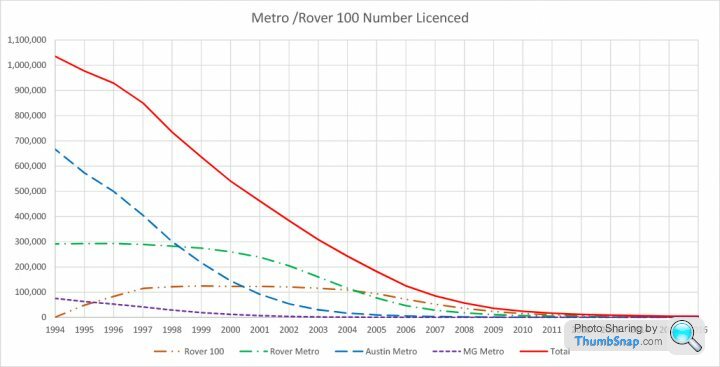
These are figures for the total number of taxed examples in GB.
I had already done the same for the Saab 9000 for another thread:
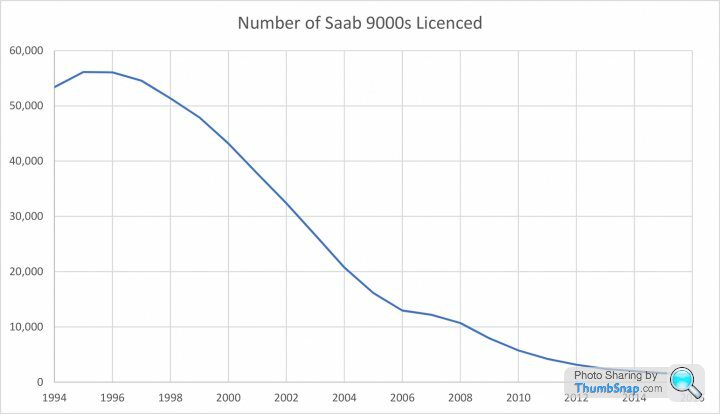
Then thought that it might be interesting to do the same for the eight most common taxed cars as at Q3 2016:
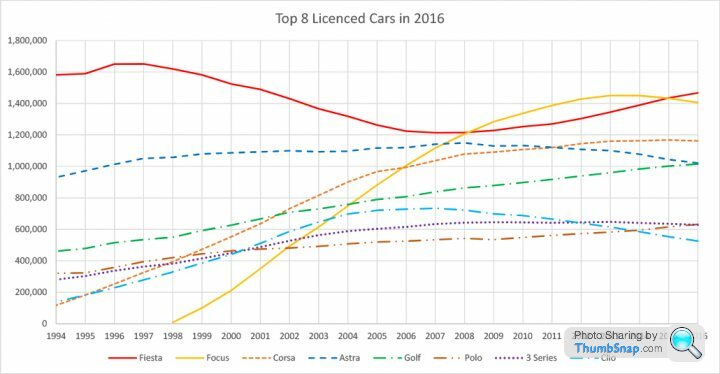
We can also add up all taxed cars on GB's roads (ever wondered why driving is getting to be less and less fun?):
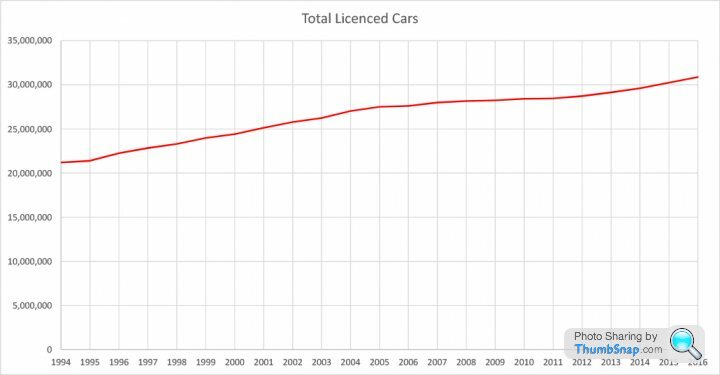
We can then get the proportion of each that makes up the population on our roads:
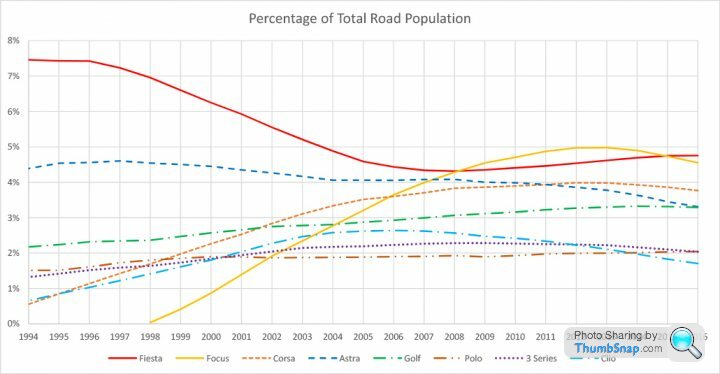
Generally, we can see the pattern that almost all "common cars" are increasingly less common as the market becomes more diverse.

These are figures for the total number of taxed examples in GB.
I had already done the same for the Saab 9000 for another thread:

Then thought that it might be interesting to do the same for the eight most common taxed cars as at Q3 2016:

We can also add up all taxed cars on GB's roads (ever wondered why driving is getting to be less and less fun?):

We can then get the proportion of each that makes up the population on our roads:

Generally, we can see the pattern that almost all "common cars" are increasingly less common as the market becomes more diverse.
Gassing Station | General Gassing | Top of Page | What's New | My Stuff



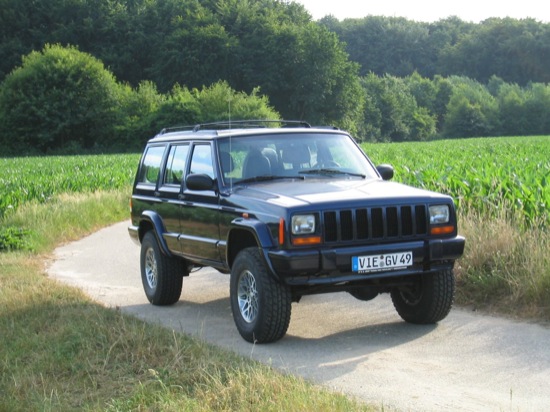
 That's some serious research there !
That's some serious research there !